Travels with Dick and Karen
Costa Rica, Part 1
Alajuela
The map is an overlay of a NASA satellite shot.
Yes, it was that green in most places and that brown (and hot) around Liberia so we spent most of our time up in the cloud forests on the moutaintops where it was usually in the mid-60s to mid-70s °F
|
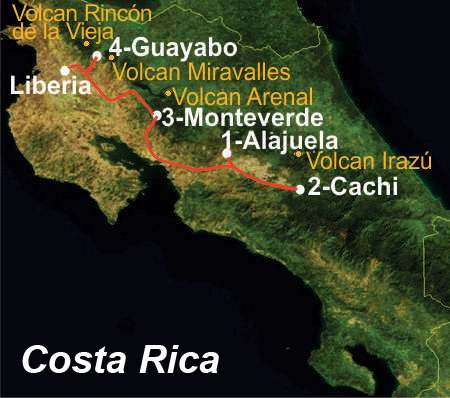 |
Mt Rainier saw us off on our way to the airport in the afternoon.
Since we were heading off to Costa Rica with a goal of visiting volcanoes, it seemed fitting. |
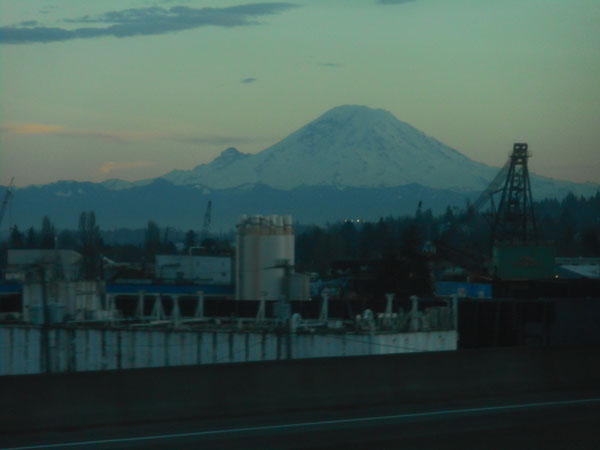 |
Making use of credit-card-related promotions, we flew Alaska Airlines. The cheap-seats routing had us flying into Los Angeles in the evening with a sleepless night layover in Terminal 6 at LAX airport... |
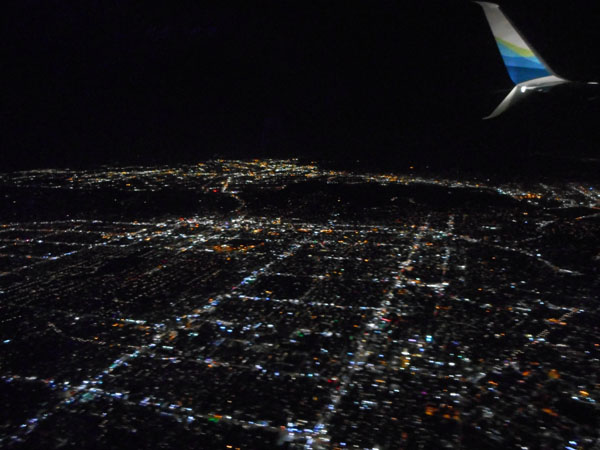 |
| ... and then we flew out at 8:20 the next morning for a 6-hour leg to San Jose, Costa Rica. |
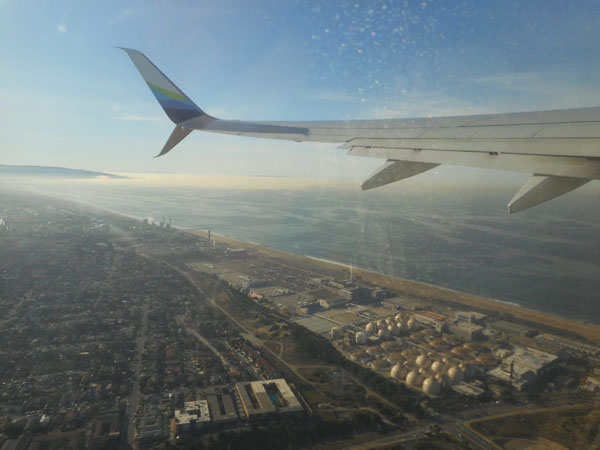 |
| We soon turned back over land and passed over the mountains of southern California. The water faintly visible under the wing is the Salton Sea. |
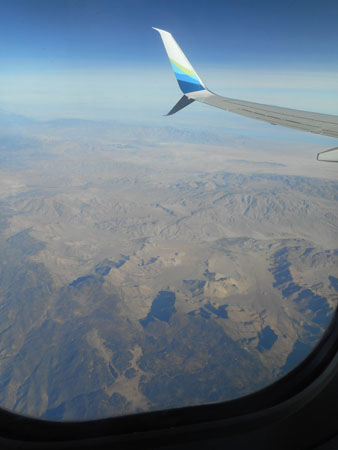 |
| Most of northern Mexico was cloudy, but three hours later we passed a few Mexican volcanoes. We haven't identified this one yet, but it's about 80 miles southeast of Iztaccíhuatl, based upon the camera's timestamps. |
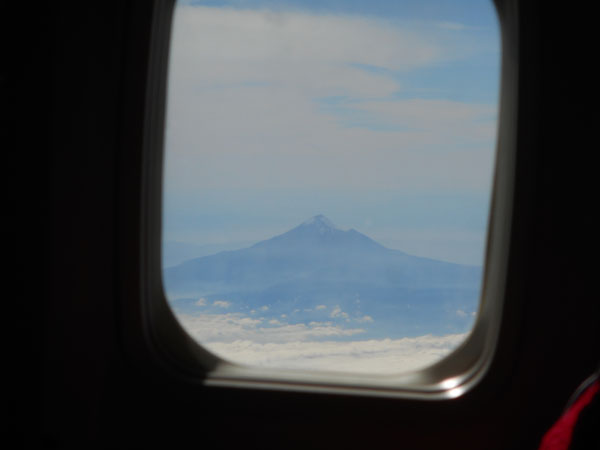 |
| ... another volcano an hour further south. |
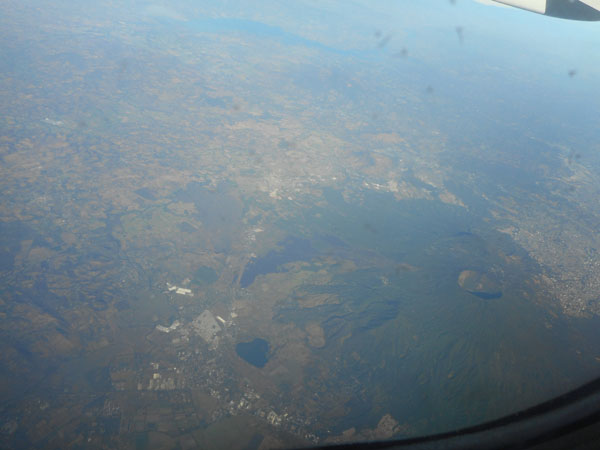 |
20 miles out from the San Jose airport (which is really just outside Alajuela, where we will be staying for the first week). The road is Costa Rica's Highway 27, a (relatively) straight-shot toll road between San Jose and Caldera on the Pacific Coast, at the mouth of the Gulf of Nicoya. This segment is just east of Hacienda Vieja. We'll take that road in two weeks. |
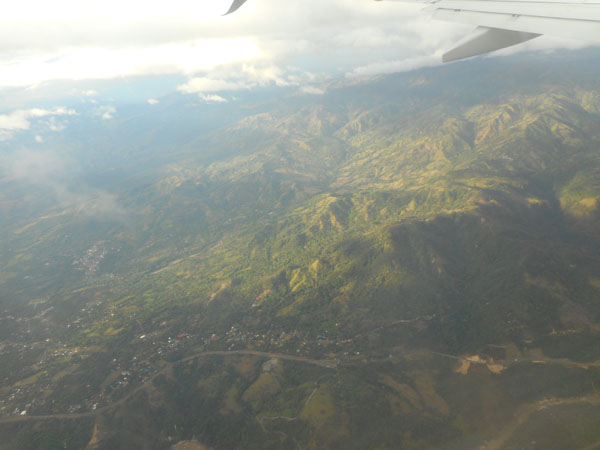 |
| We managed to do the south-bound trip with only carry-on luggage. Not having to wait for baggage let us be a bit ahead of the crowds. Our first stop is to buy a Kolbi SIM card to make our cell phone a local phone. About $20 gave us 30 days with 2 gigabytes. |
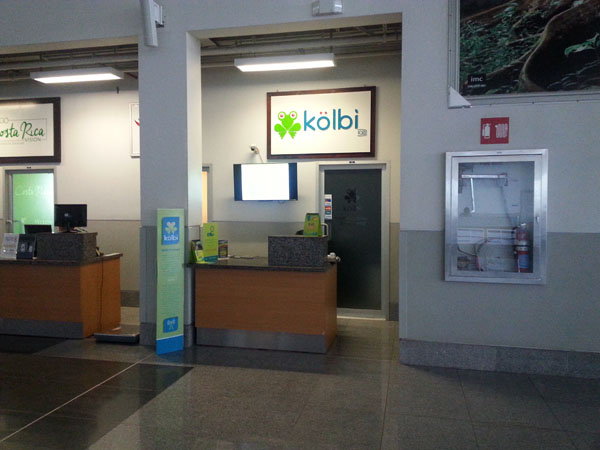 |
And then into Alajuela by taxi. |
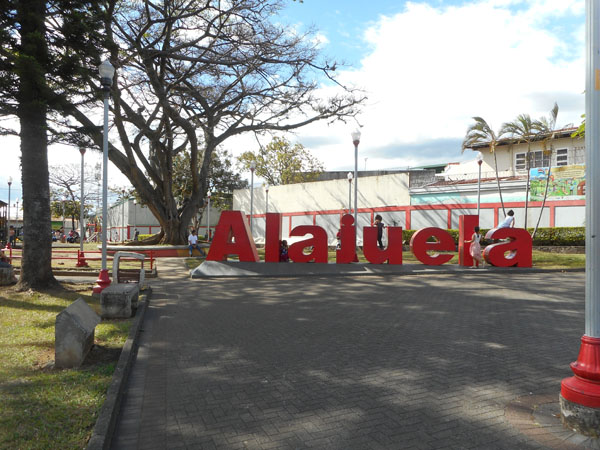 |
| We used AirBnB for all of our lodging arrangements. Maria's apartment building was tucked away and quiet, even though it was only 4 blocks north of the center of Alajuela. Our balcony was up 1 flight of stairs on the right. Helpful Domingo, the caretaker, lives in the house at the bottom of the parking lot. |
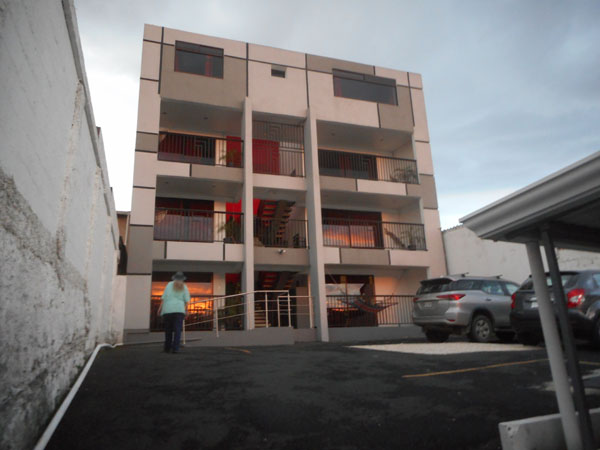 |
| Our very comfortable home for a week. |
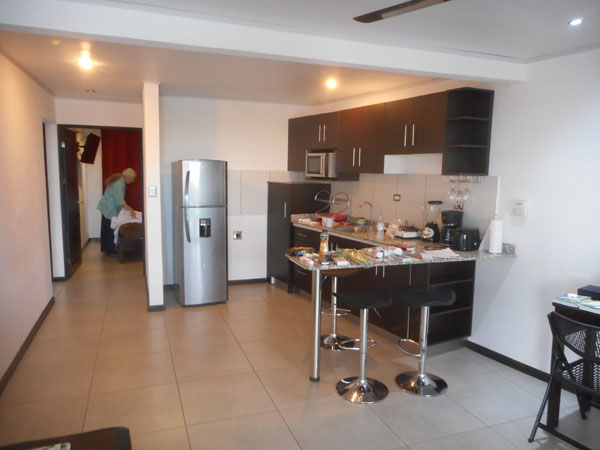 |
| Karen's bellwether for comfort: a hot shower. |
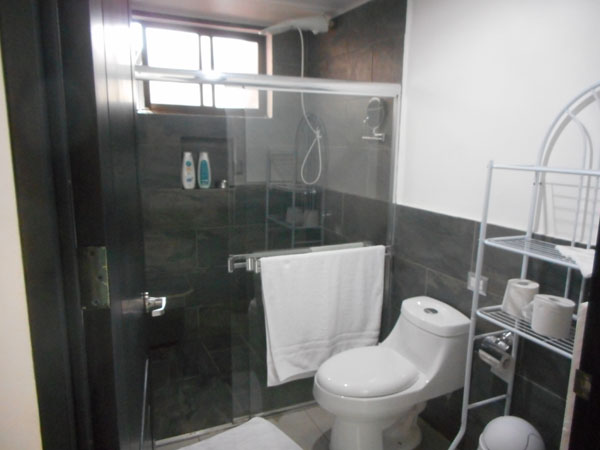 |
| Windows facing the west ... |
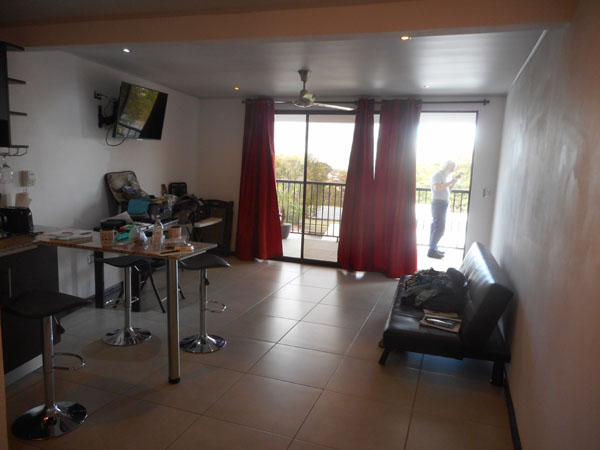 |
| ...and a resident gecko. |
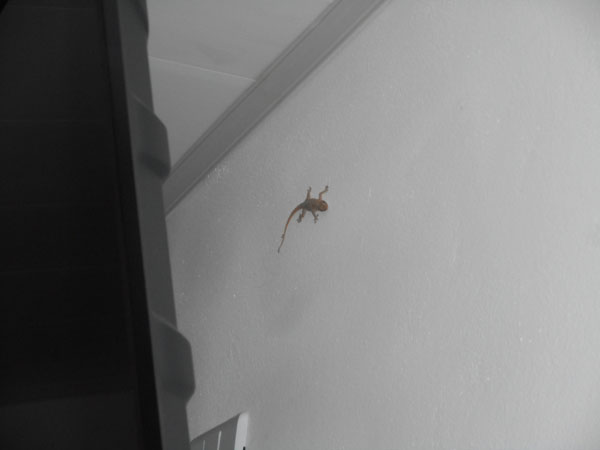 |
| The next morning looked fair |
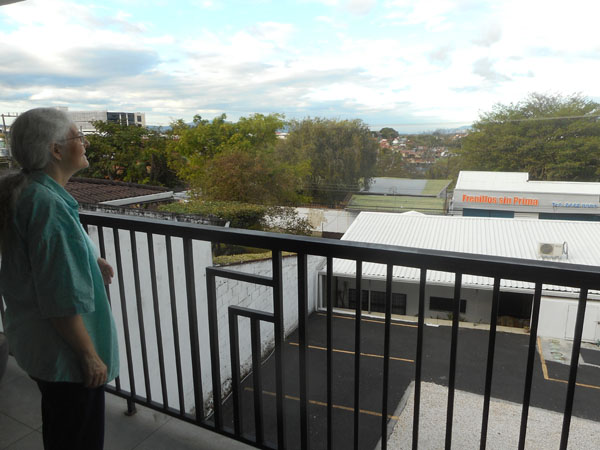 |
| ... even though the forecast was wet. Quality of the forecasts varied quite a bit depending upon our locale. |
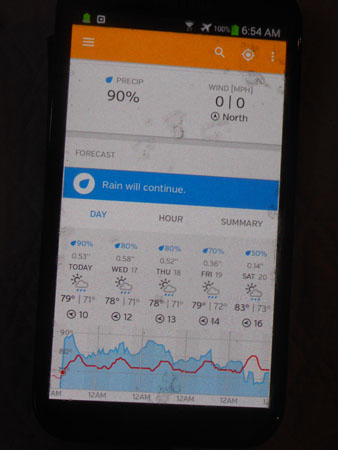 |
We ate the oatmeal we brought from Seattle and airport orange juice for breakfast and headed out on foot for groceries. |
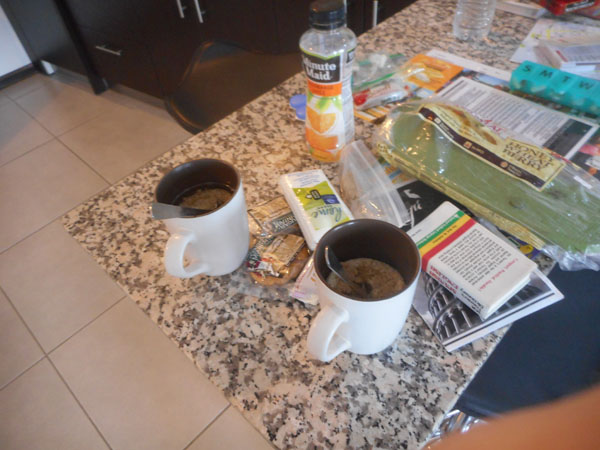 |
| Maria furnished a map of the town. Our apartment is the orange square at the top of the map. The yellow outside streets are (in theory) two way traffic and all those inside the boundary are alternating one-way. |
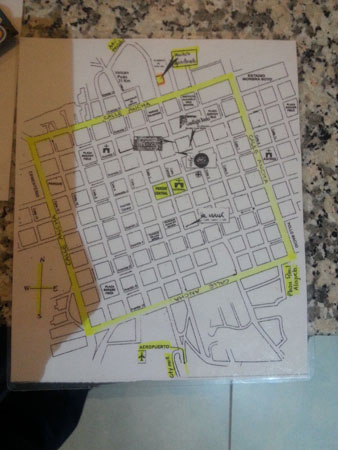 |
| A block south of the apartment was the Parque de Palmeres |
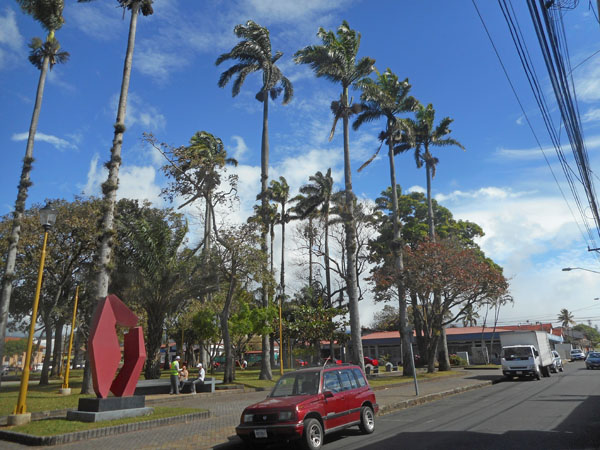 |
| Half-way to the grocery store was an inviting "am/pm". We couldn't resist some more OJ and coffee |
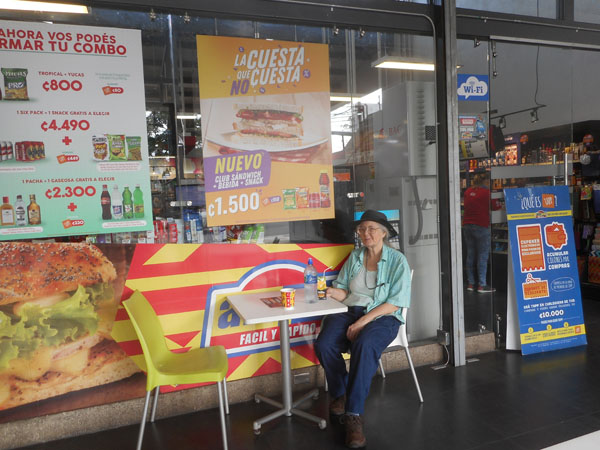 |
| Two blocks further on was the Palí grocery store. We found this chain to be for those who are watching their pennies and buy in bulk. Later we found the "AutoMercado" where we could buy in smaller quantity and with a broader range of choices. They also had a good in-house bakery. |
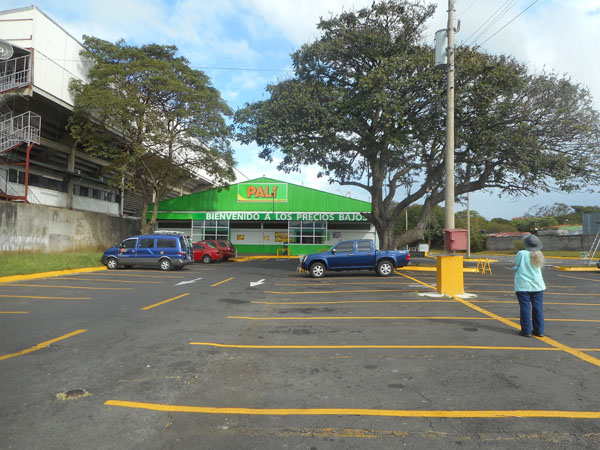 |
After the shopping, Dick inspected his change to learn the new coinage. Costa Rica uses "colones", with the biggest coin being a 500, about $1. After that it's plasticized bills, like much of the world. Thus a 1000 (1 mil) bill is $2.
Throughout the country, US dollars are very frequently freely usable. Tourist stops often had their posted prices in dollars, partly with the goal of acquiring currency suitable for importing items not produced in Costa Rica. |
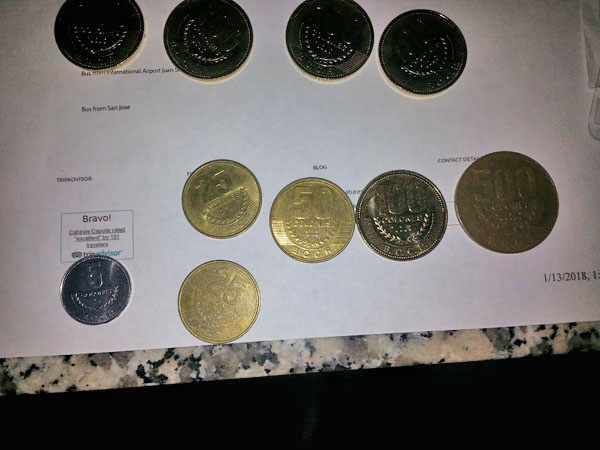 |
Alajuela, like many of the cities, was centered on a cathedral and associated park. Although quiet in the mornings, it became the center of activities at lunchtime and on the weekends.
After walking the main square we had lunch at a small bakery, Café Delicias. It was.
| 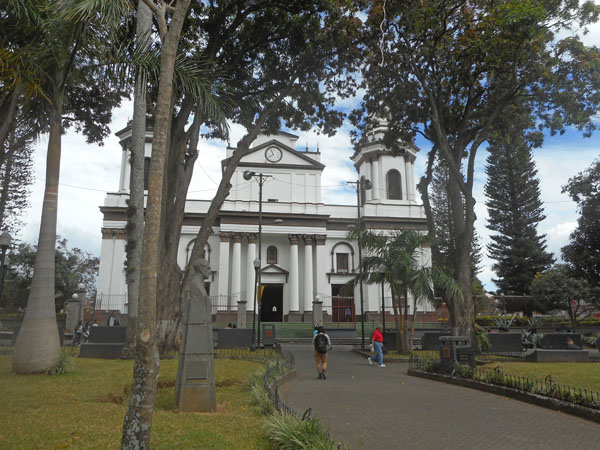 |
| Parque de Palmares was also the location for the local taxi ranks.... that line of red cars on the left. In the afternoon we wandered over and caught a taxi to Vamos to pick up our car. The traffic honored the walk lights. |
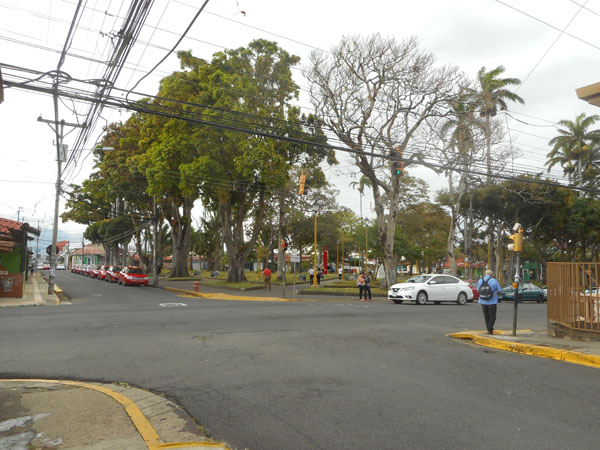 |
We had delayed picking up the car until the day after our arrival. This was to both give ourselves time to slightly recover from the flight, and to make the rental period only 30 days to squeak into American Express' insurance coverage window. Instead of the smaller Daihatsu BeGo we were expecting, we were given a brand new SsangYong Korando 4-wheel drive automatic which still had paper plates ... for the same price. All told it was slightly under $1800 for the month. We knew we'd occasionally need a 4-wheel drive since we weren't simply staying in the central valley.
Vamos was an excellent company to deal with. We had made our reservation on-line the month before. The pick-up process was completed in less than half an hour from walking in the door to wondering how we'd weave back "home" through traffic.
As the photo shows, we did manage to bring it unscathed to Maria's secured parking area. |
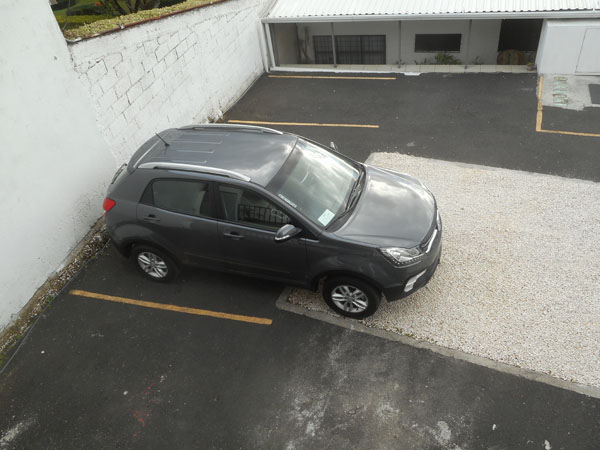 |
| That afternoon we could see the sunlight glinting off the Pacific (well, the Golfo de Nicoya to be precise). |
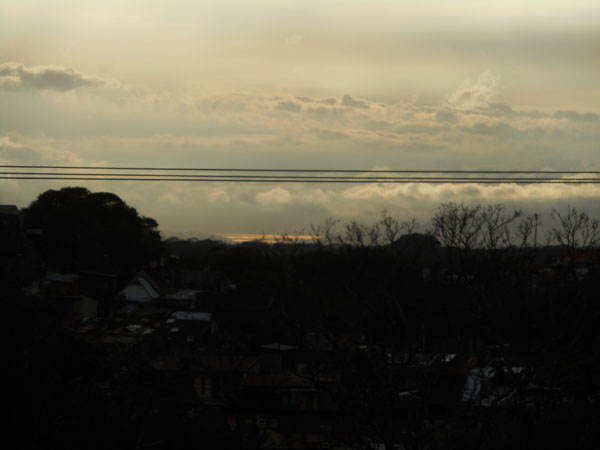 |
The next morning we had to deal with getting the car back out the narrow drive with automatic gate.
Then it was "simply" "take a left, then the first right, and follow Rt 3". Since it was our first drive out of town in unfamiliar traffic and drivers' (and motorcyclists') habits, it felt like 20 miles. It was 5.
|
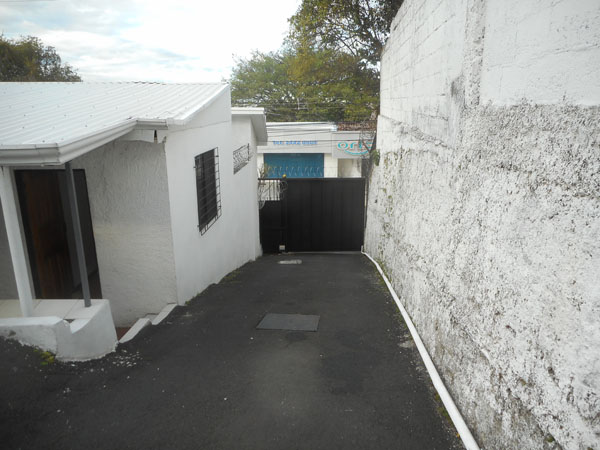 |
Our goal was an animal sanctuary slightly west of town called "Zoo Ave". The "Ave" is pronounced Ah-vay and is the Spanish word for "bird". There were also lots of plants. |
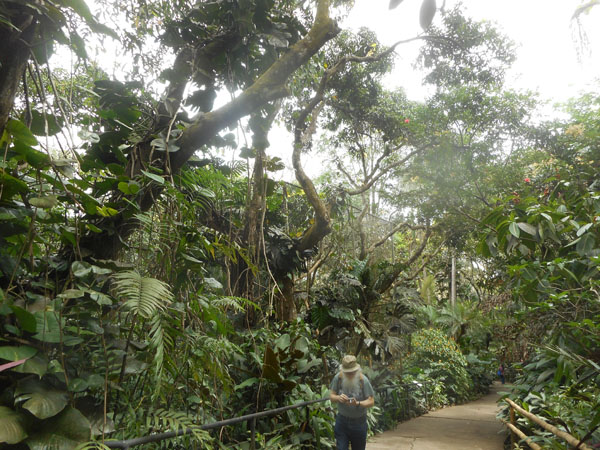 |
| LOTS of plants... some with explanatory signs. |
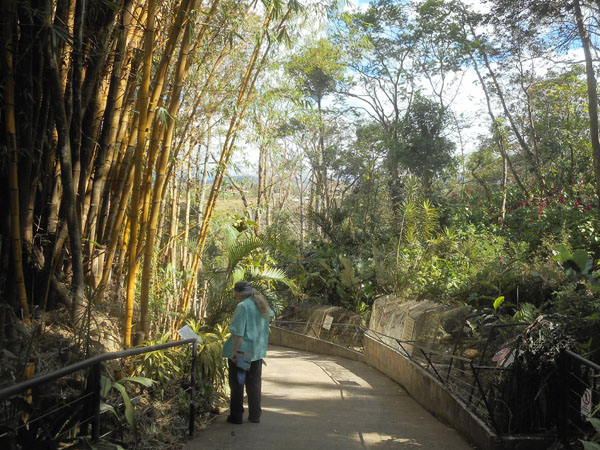 |
And lots of rescued birds and animals. All of the creatures here were confiscated from sugglers, illegal pets, or injured animals found in the wild and belong to the government. This is one of many facilities which contract with the government to provide care for those animals which can not be released back into the wild.
Unlike some of the other sanctuaries we visited, "Zoo Ave" does have a rehabilitate-and-release program. |
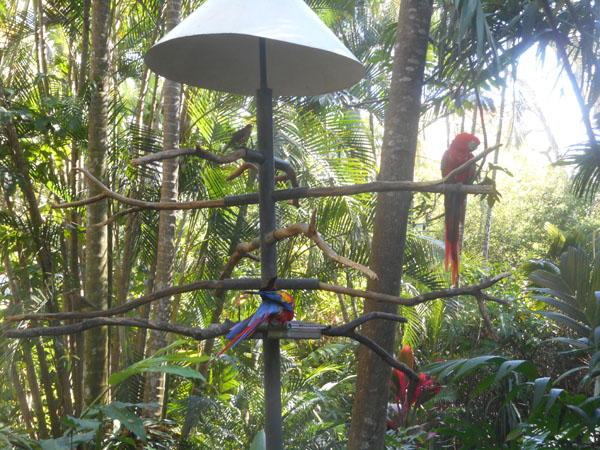 |
| |
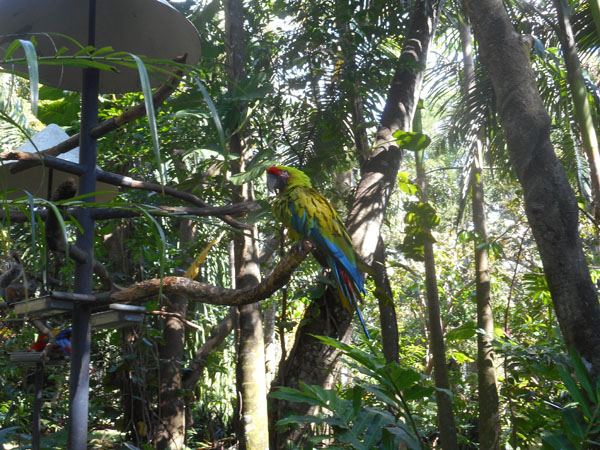 |
| And some local animals which are taking advantage of the available food in the parrots' cage. |
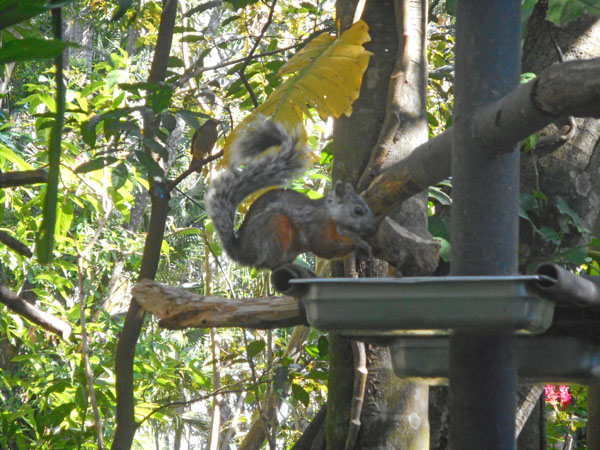 |
| ... although some were official exhibits. 450 squirrels have been returned to the wild. |
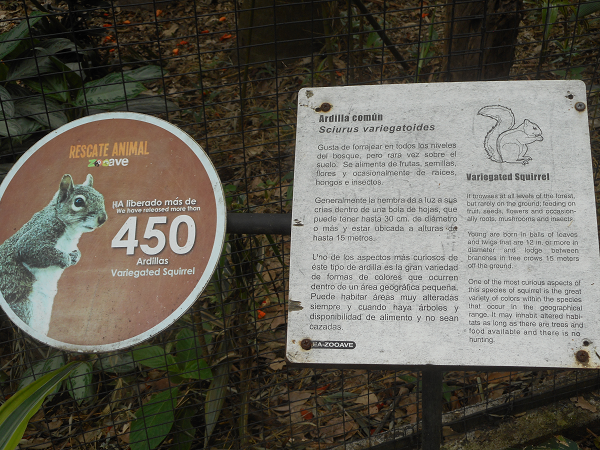 |
| Brown pelican (and whistling duck) |
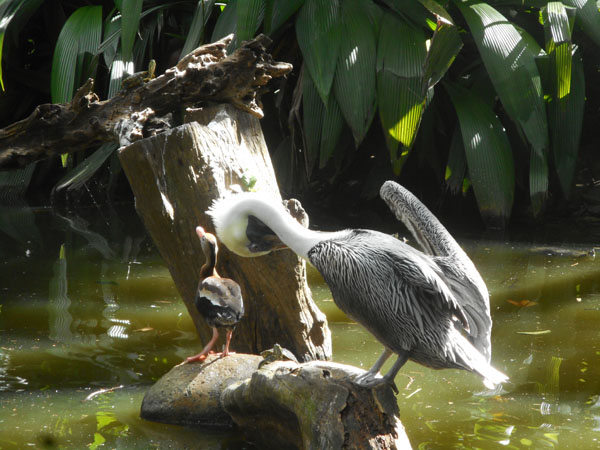 |
| More ducks, turtles and iguanas (the big iguana was chasing the smaller away from the food bowl when we arrived) |
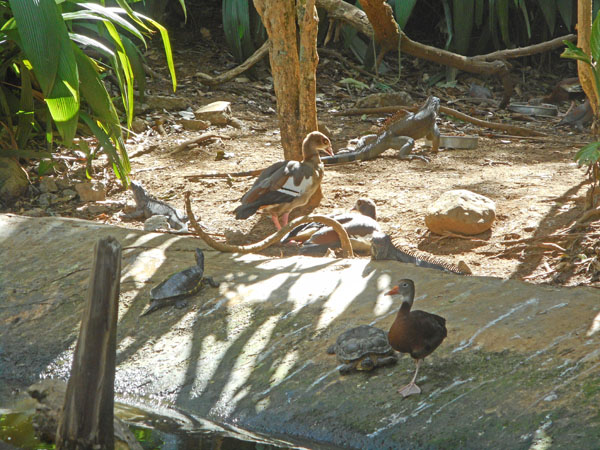 |
| |
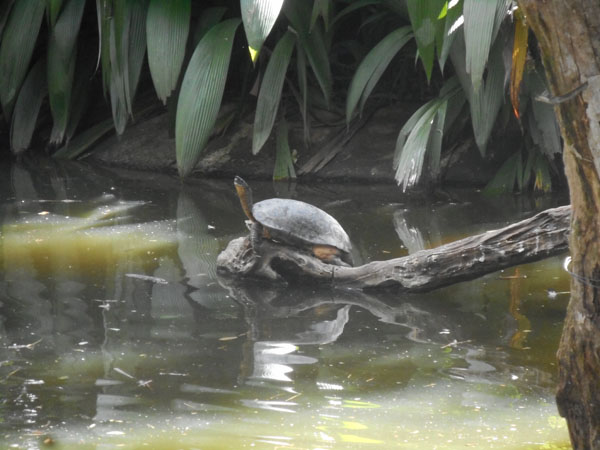 |
| American crocodile |
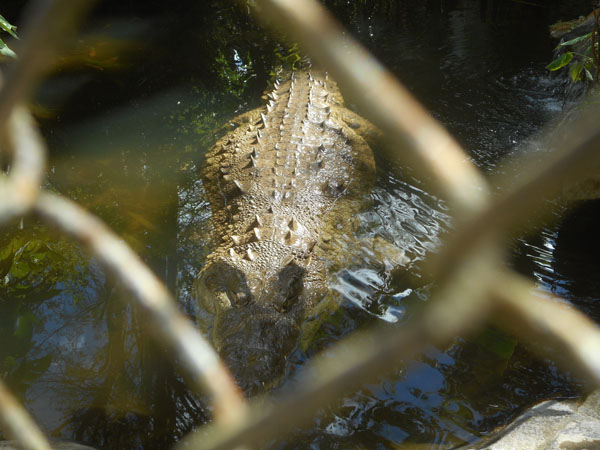 |
| Wood stork |
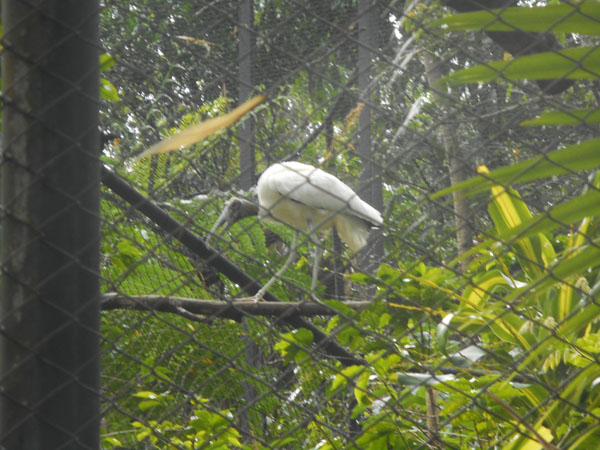 |
| Fiery-billed aracari |
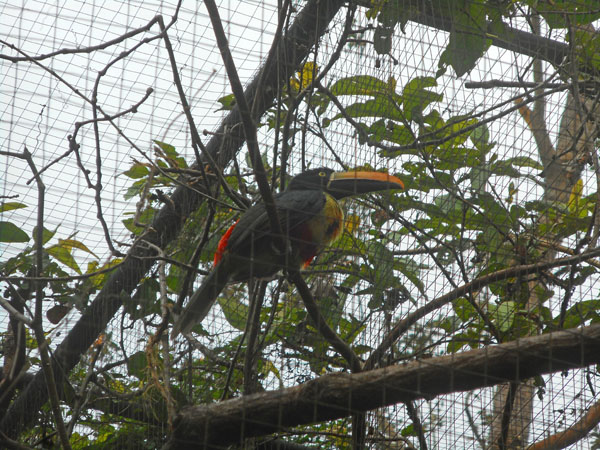 |
| Chestnut-mandibled Toucan |
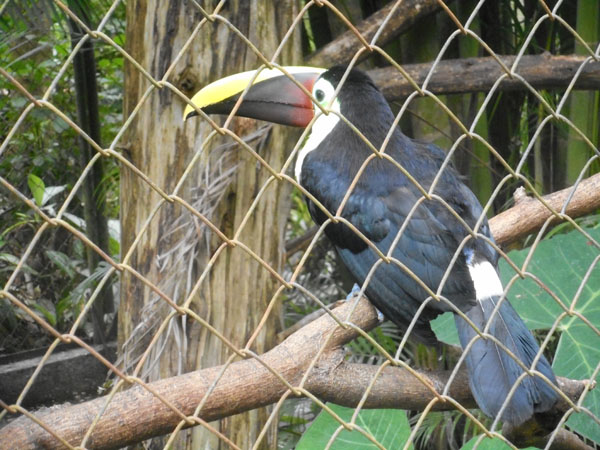 |
| Clay-coloured robin (the national bird: we met them everywhere during our month) |
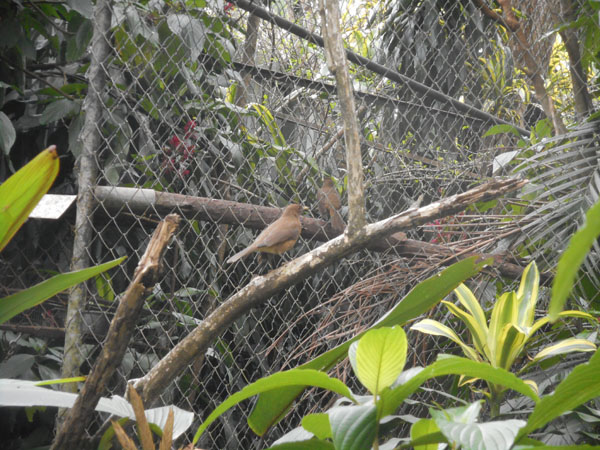 |
| One of the few "there's a bird in there" photos that is worth showing you. |
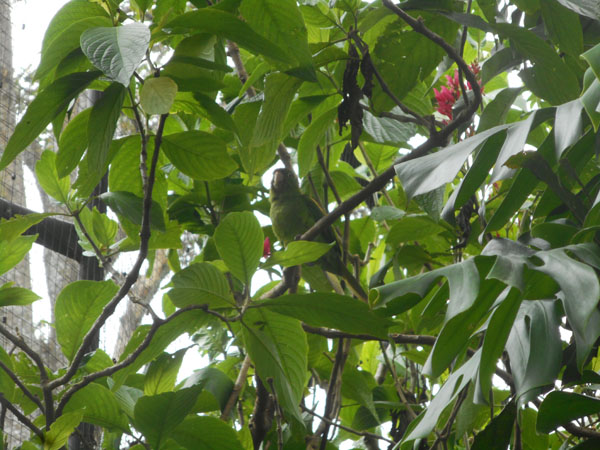 |
| Black Guan |
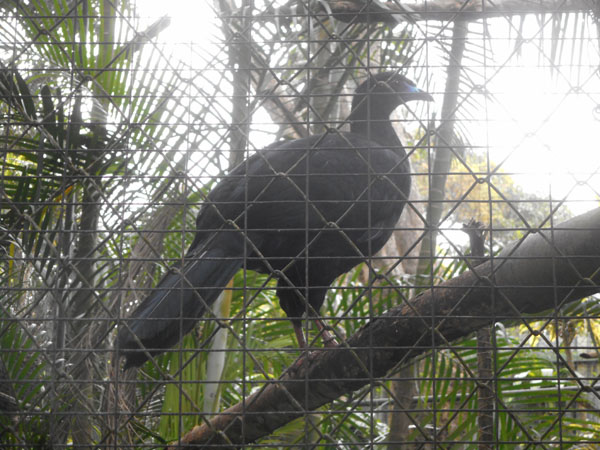 |
| Crested Guan -- who we'd meet again near Guayabo |
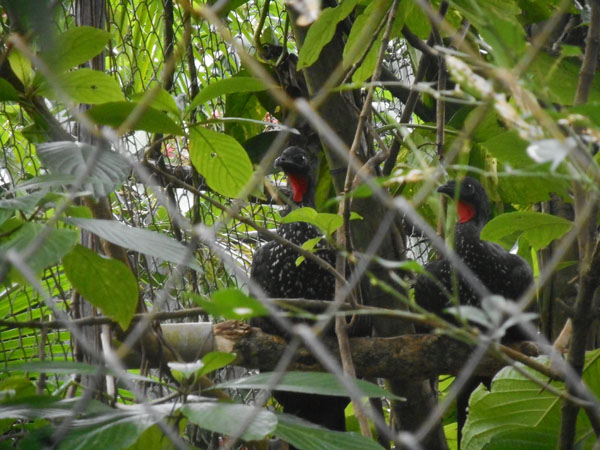 |
| Great Curassow (female) |
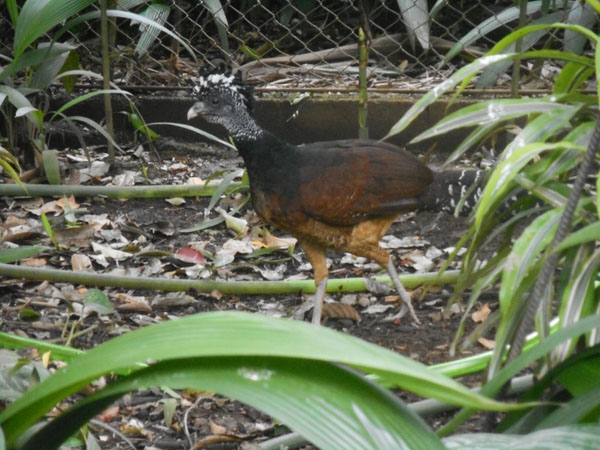 |
| Great Curassow (male) |
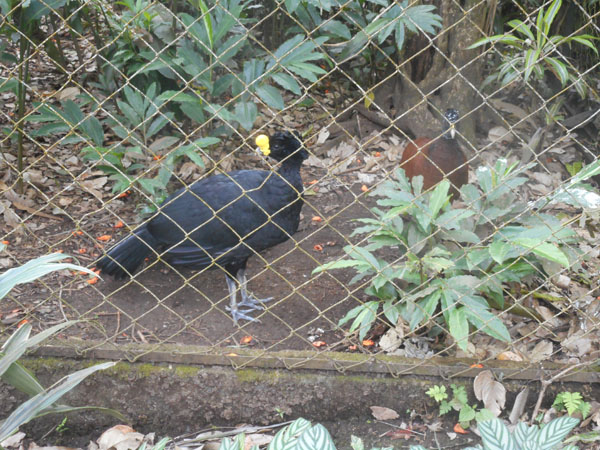 |
| Oropéndola ... a bird we'd meet frequently in Cachí |
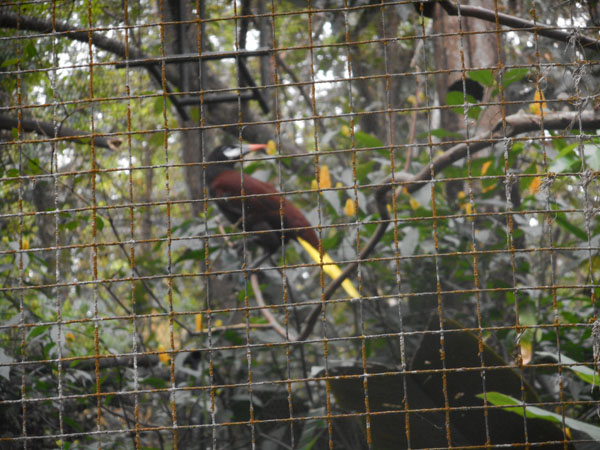 |
| And an array of raptors |
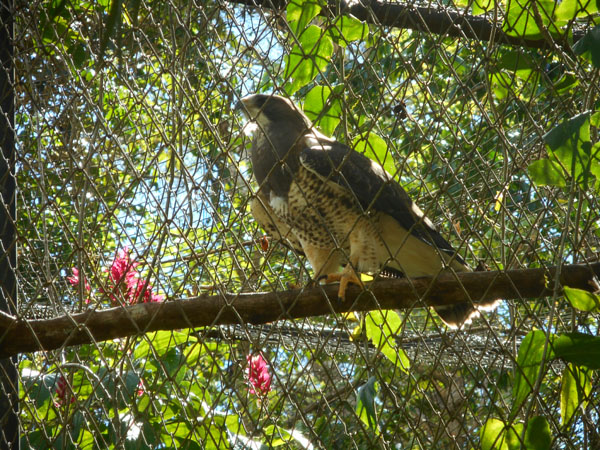 |
| An "Ornate Hawk-Eagle" |
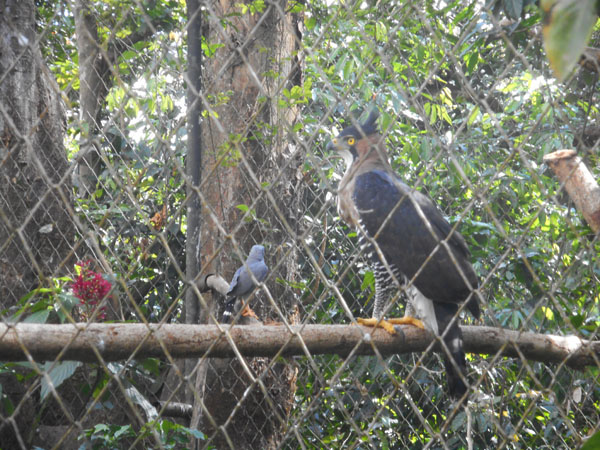 |
| A sloth, in the usual pose. |
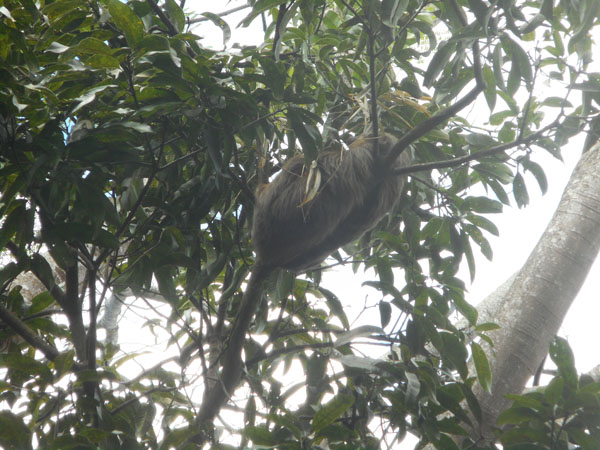 |
| An active agouti |
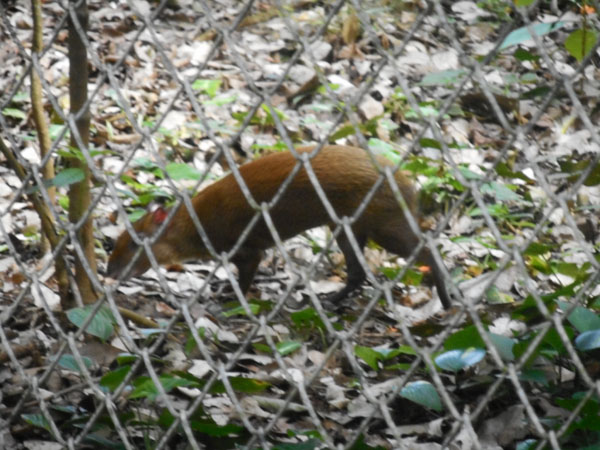 |
| Peccary |
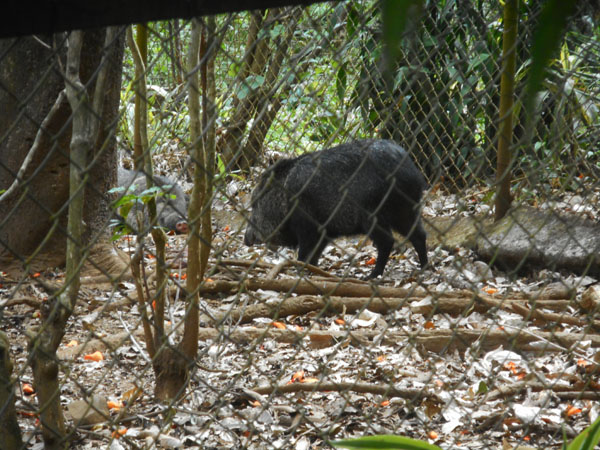 |
| Several coyotes |
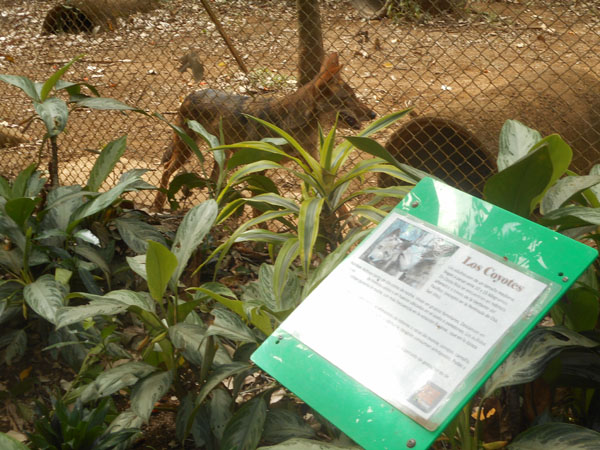 |
| Monkeys (there are 4 native species) |
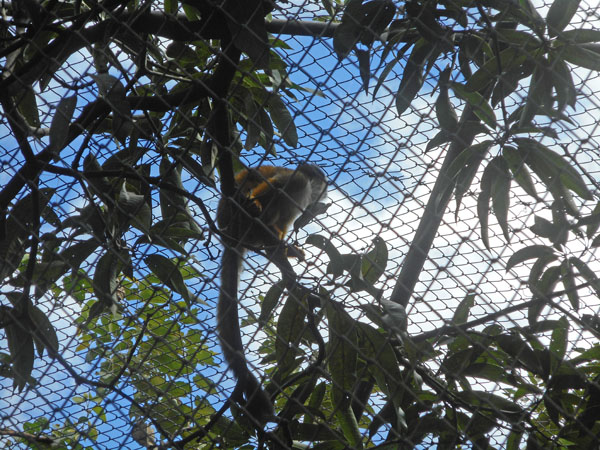 |
| Mountain lion |
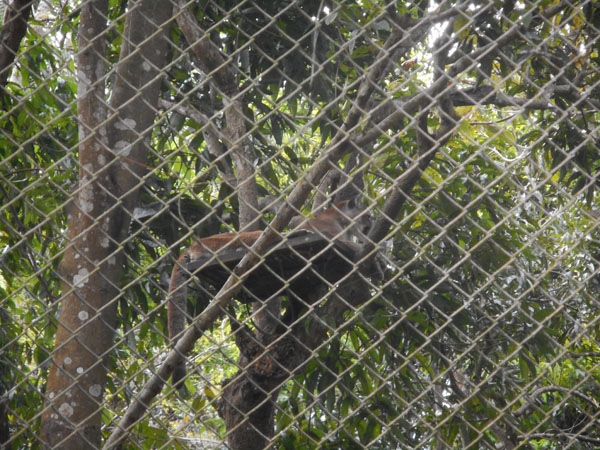 |
| and other cats (several similar species) |
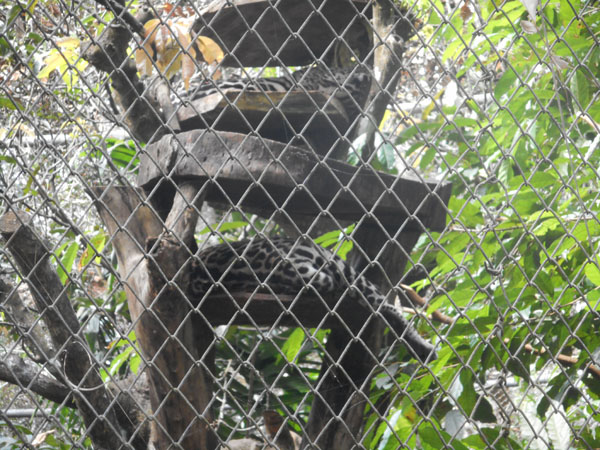 |
| And several non-natives like this tortoise |
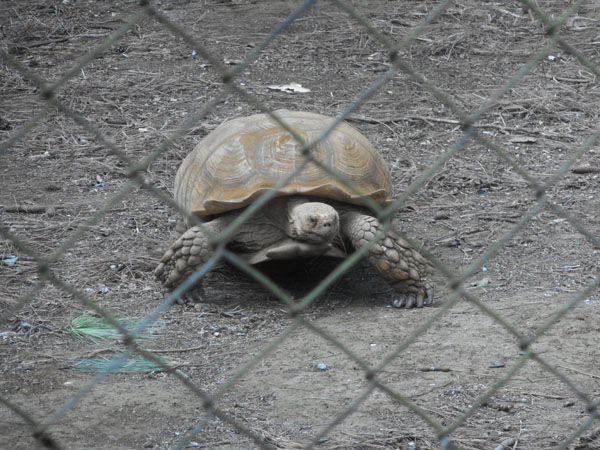 |
| Emus |
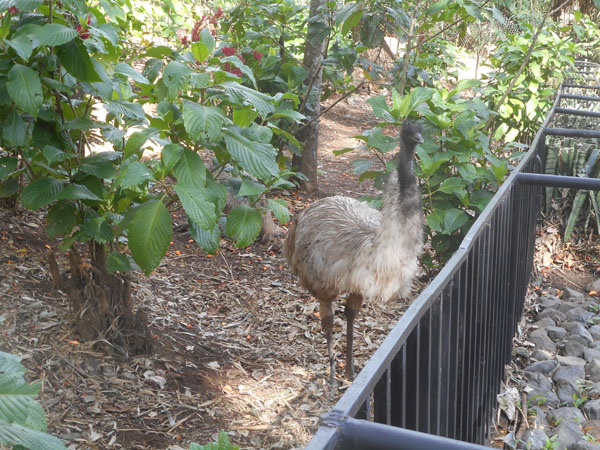 |
| Lemurs |
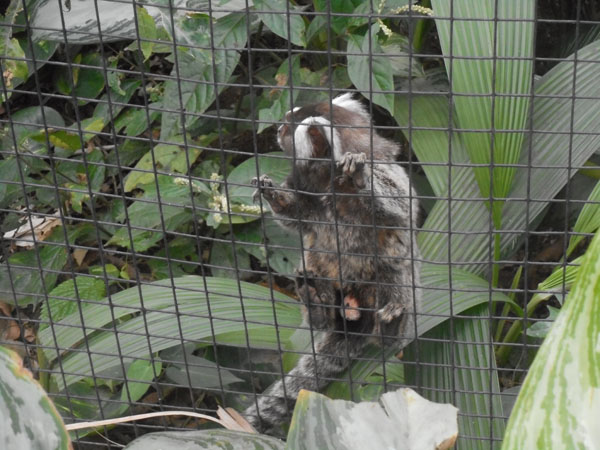 |
| and even a hedgehog |
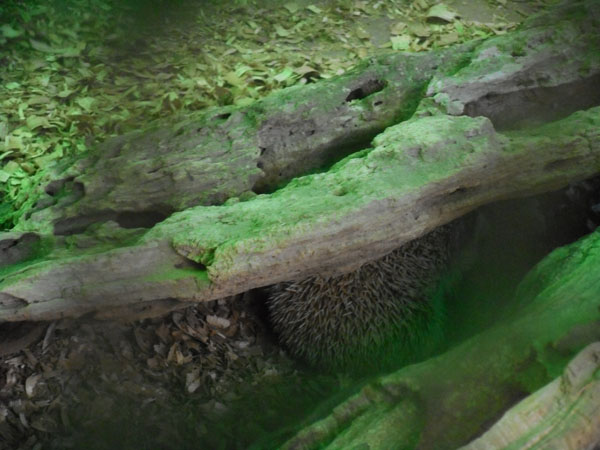 |
| And then there were the local iguanas...once we started looking, they were everywhere. |
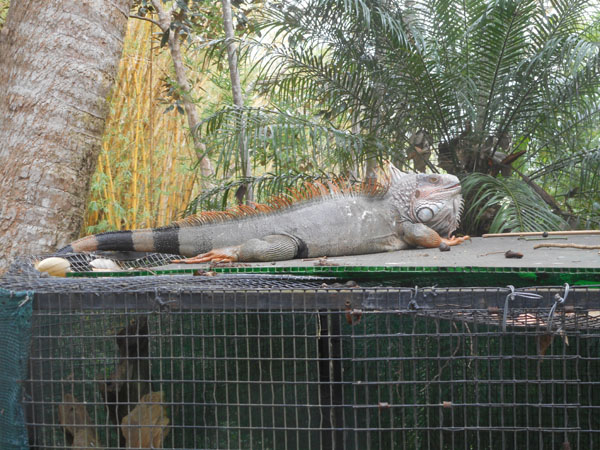 |
| The males turn orange when getting ready to fight for mates. |
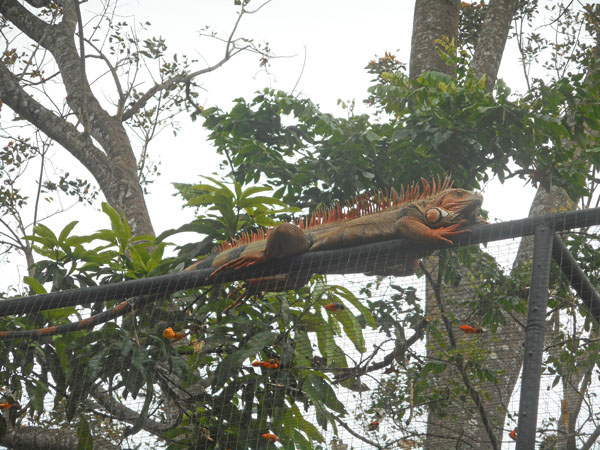 |
| |
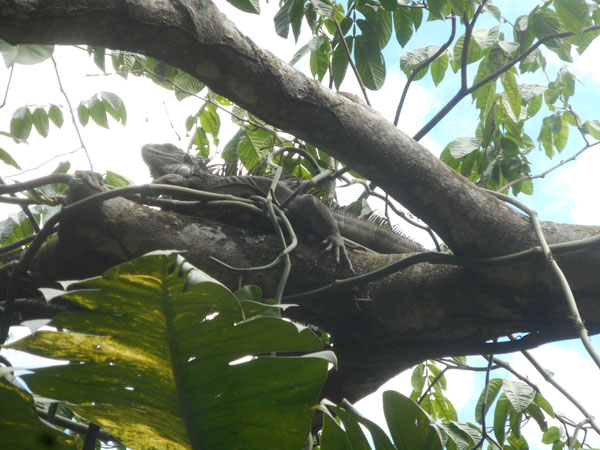 |
| |
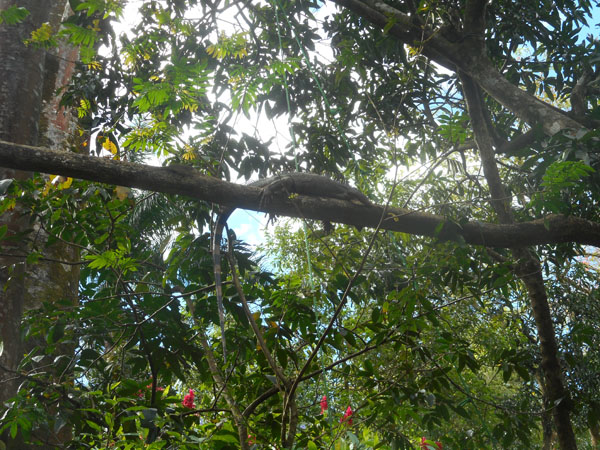 |
| |
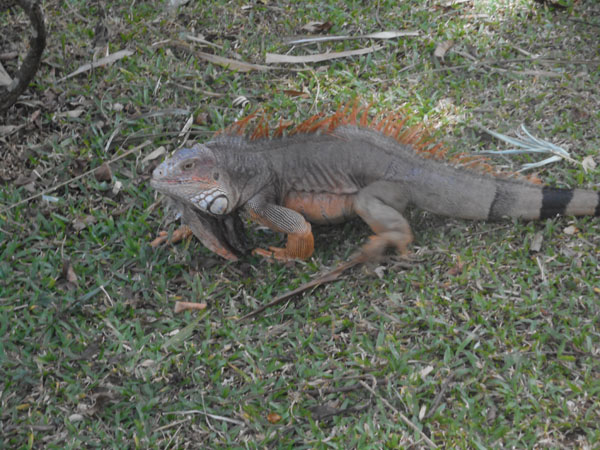 |
| ...even blocking the path to the restroom. |
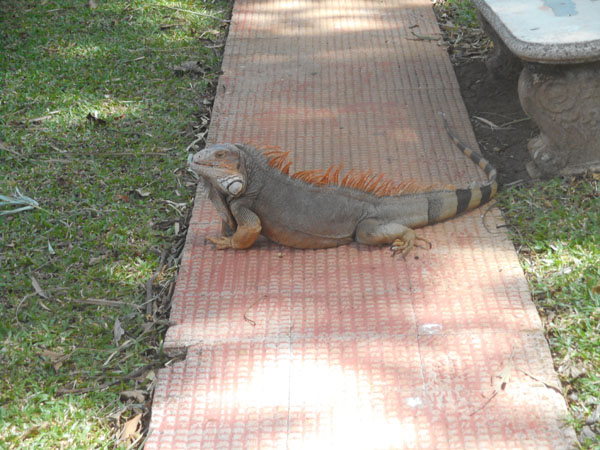 |
| Whereas the peacock was blocking the way to the restaurant. |
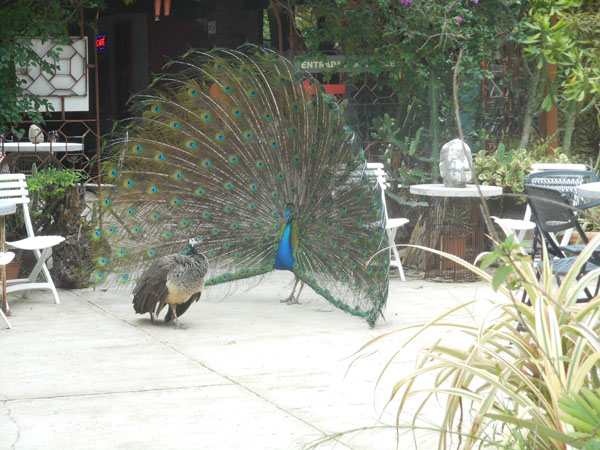 |
| Where we had a nice lunch... |
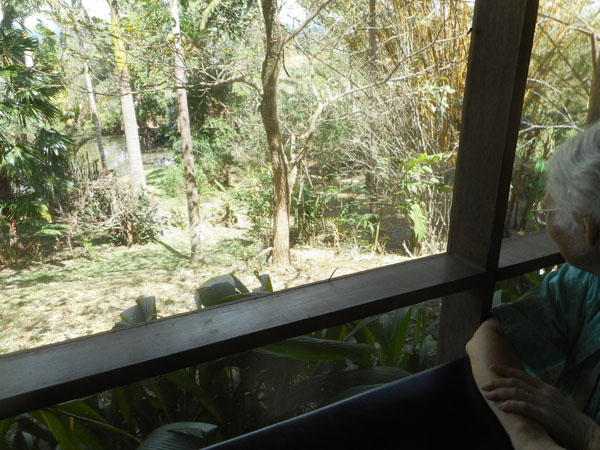 |
... watching iguanas going up and down the tree on their way to/from the roof.
After lunch, we left Zoo Ave and had the first of our (many) "GPS Adventures" ... discovering unexpected routes that didn't exactly end up where we wished to be... |
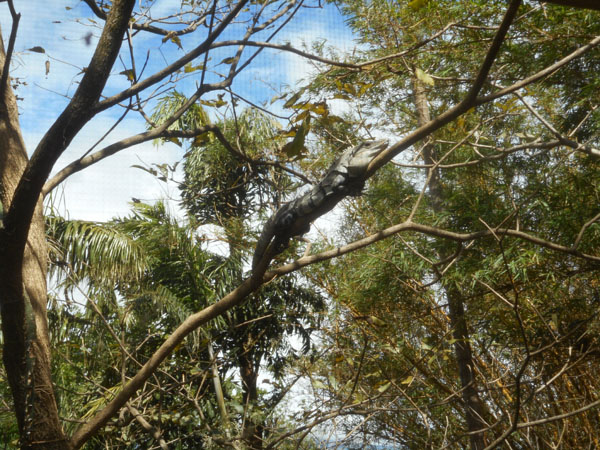 |
Eventually we did manage to reach the "Jardín Botánico de Orquídeas" in the town of La Garita.
It was developed on a forested ex-coffee plantation. This bouganvilla filled one side of the parking lot. Can you spot the bird? (probably one of the many similar flycatcher species) |
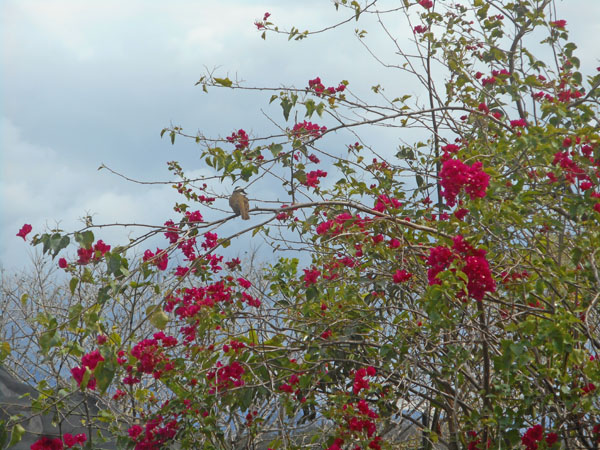 |
| House plant on steroids, er, sunlight. |
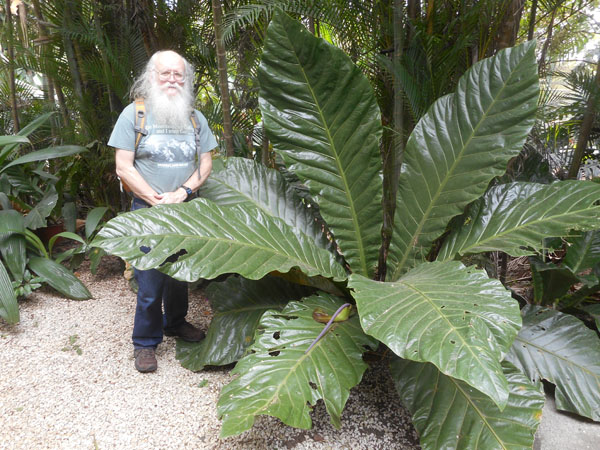 |
Lots of blooming orchids, not all native.
This was their "featured display" room. |
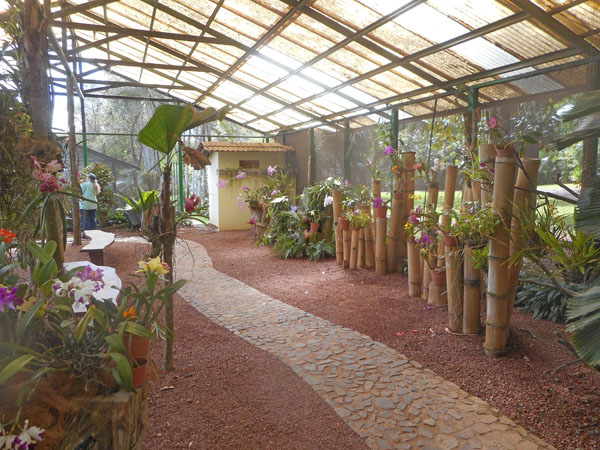 |
| |
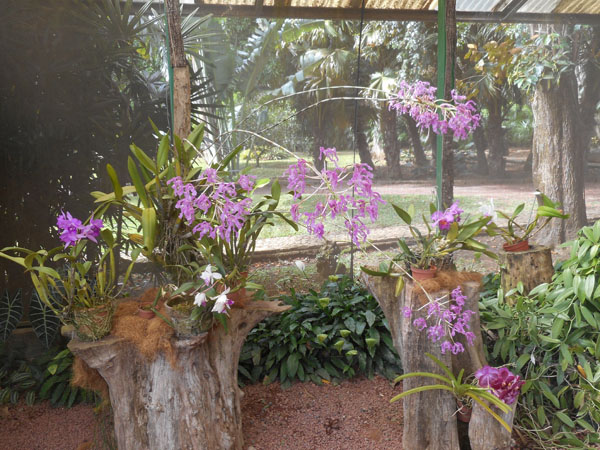 |
| Then we went into their general propagation and growth rooms. |
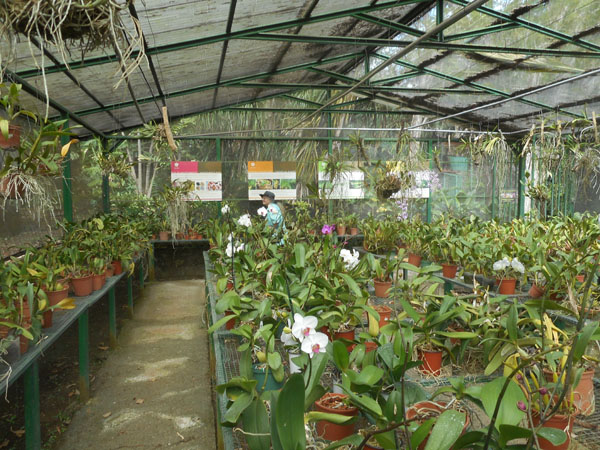 |
| The signs on the wall describe their techniques: when the seed pods open, the dust-like seeds are transferred to agar laced with minerals and sugars and sealed into flasks. After 8 months or so in the flask the plants are transplanted into "communities". The close packing of a 10- to 100-member community helps maintain a favorable microclimate. They'll be grouped like that for another year. At the age of two years, they're finally individually potted. For the next three years they'll be transferred to larger pots as necessary. Only after 4 or 5 years are they mature, ready for sale and blooming. |
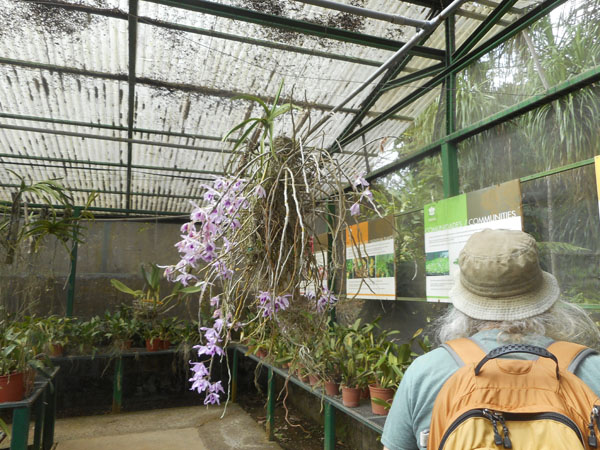 |
| |
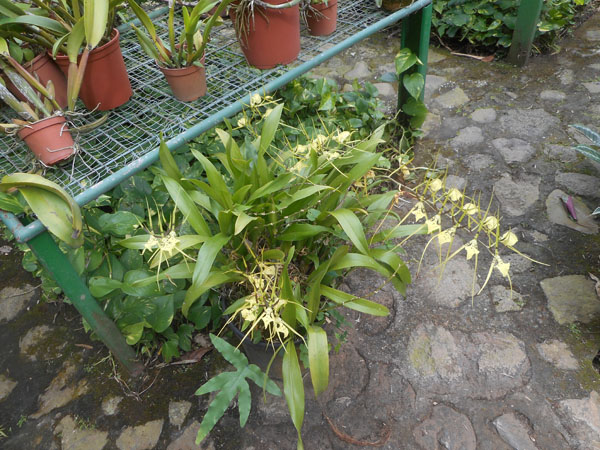 |
| A wall of bromiliads |
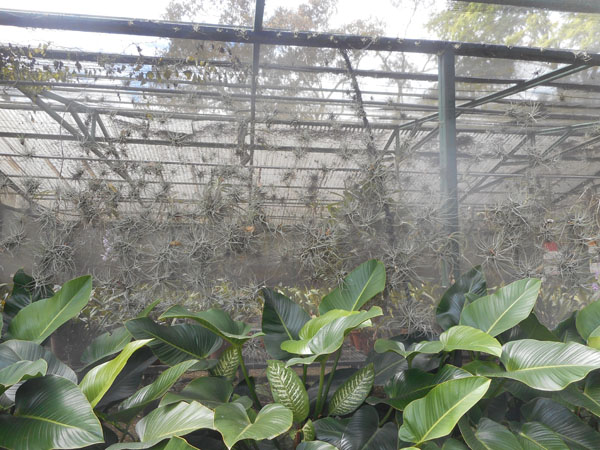 |
| Dick went into the bamboo |
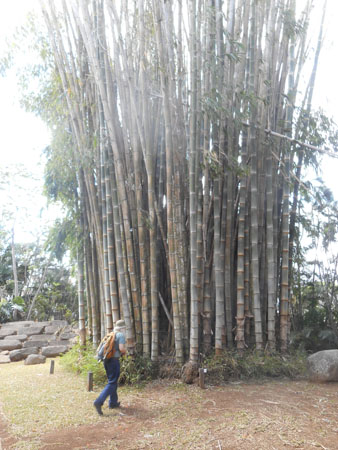 |
| for this shot |
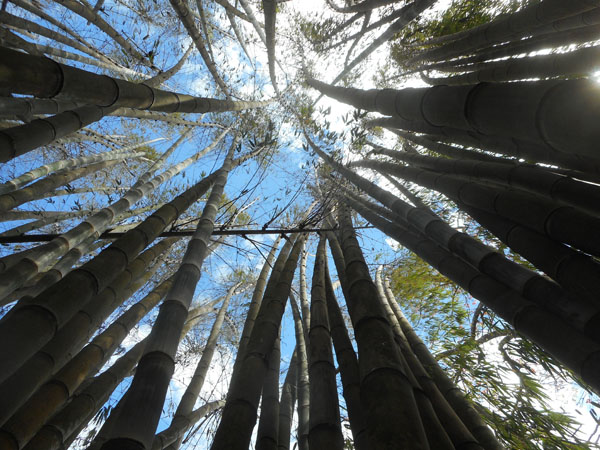 |
| Karen looks at the small blooms on some huge (and probably very old) orchid plants |
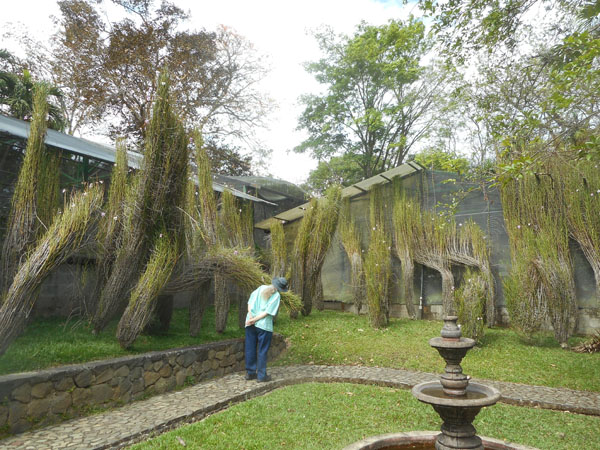 |
| Aristolochia species, huge weird flowers and pods. They smell like carrion to attract beetles to pollinate them. There are around 500 species, all tropical. |
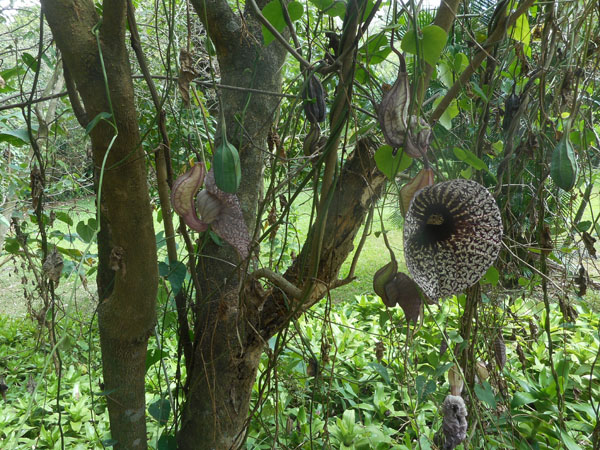 |
We would often find petals on the ground before looking way up to spot the tree from which they came.
We repeated that ritual throughout the trip. |
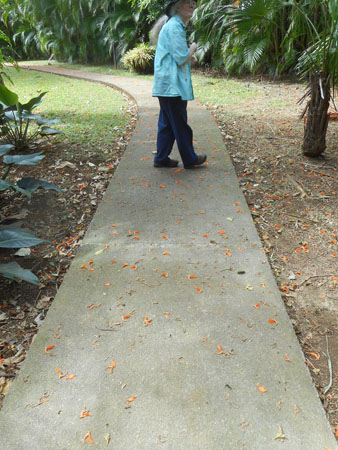 |
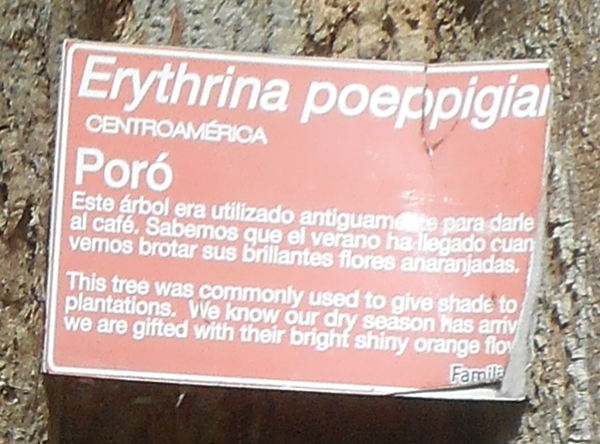
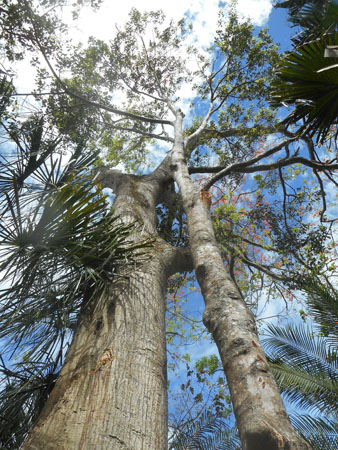 |
| The last area was a children's playground. A ladder into a spiky Ceiba ("silk cotton" or kapok tree) -- maybe so the kids can feel the spikes. |
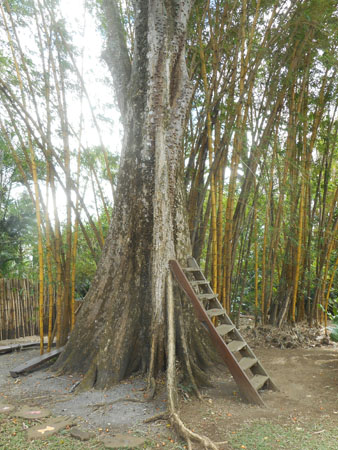 |
| Returning to Alajuela, we were welcomed home with another stunning sunset |
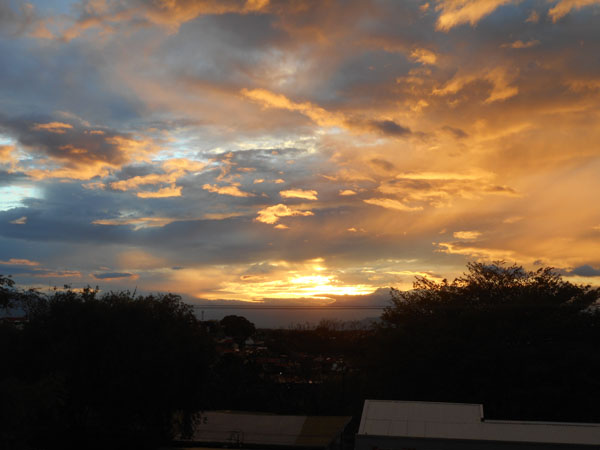 |
| The next morning we got out early to see if the Poás volcano park was open.
Although the weather in Alajuela was clear, the hills visible from our balcony were socked in. We headed north on Rt 130 and drove up into the clouds. |
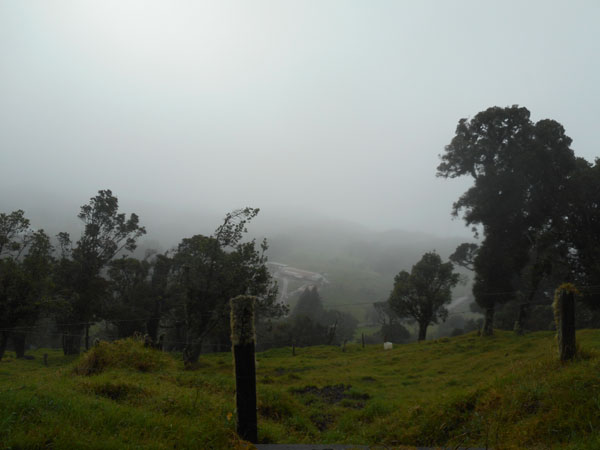 |
As we neared the Volcán Poás National Park entrance, it started raining.
Eventually we reached a set of sawhorses barricading the road, with a sign saying that access (and the park) was closed due to volcanic activity. We'd made the drive on the off chance that the park had been reopened, but it hadn't. The weather would've been a damper, anyway.
We did a multi-spoked Y-turn in the road (without thinking to take a picture of the blockage), and came back down to this restaurant's parking lot for a reconnoiter. |
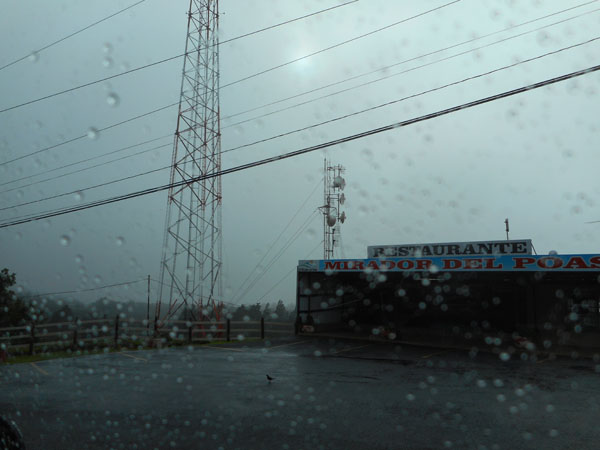 |
| Plan B became going a few wet miles west from Poás to the La Paz Waterfall Gardens. |
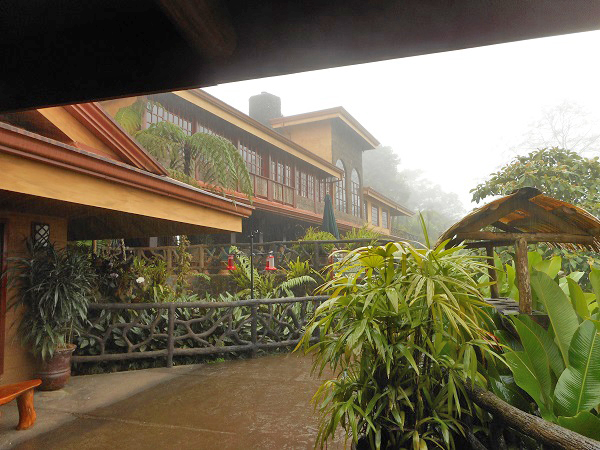 |
| Despite the rain (apparently a dry day is rare) the walkways were not slippery. |
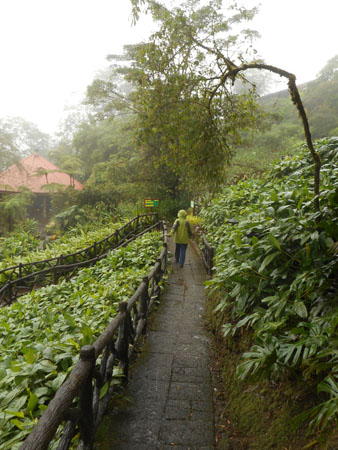 |
| A very wet emerald toucanette at a feeder |
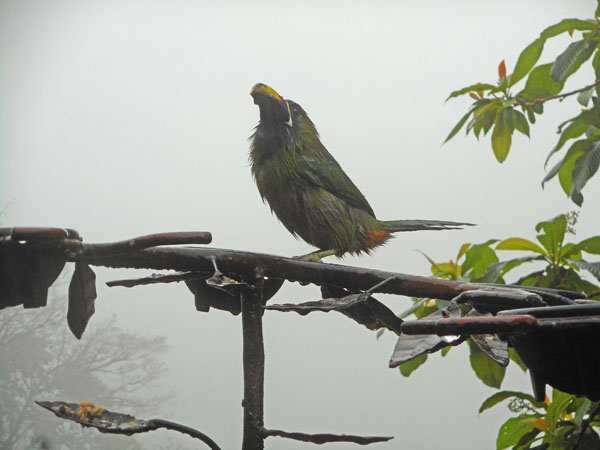 |
| The facility had a huge butterfly house... thousands of butterflies being hatched, reared and flying free. These are morphos... |
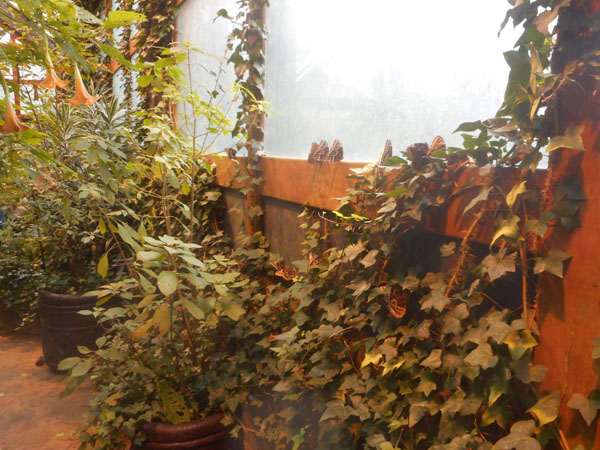 |
| ... brown with "owl eyes" on the lower surface of the wings, and that's what you see when the wings are closed. This one is resting above a row of cocoons. |
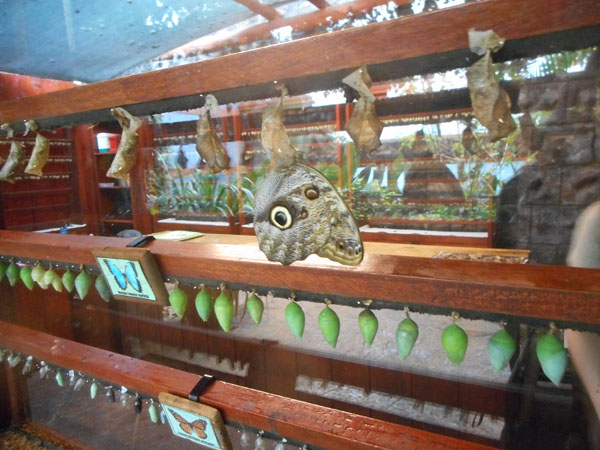 |
| But when the wings open their brilliant blue shines. The adults live only a week or two. When they die (like this one) the wings are sold to make jewelry and butterfly-wing art. |
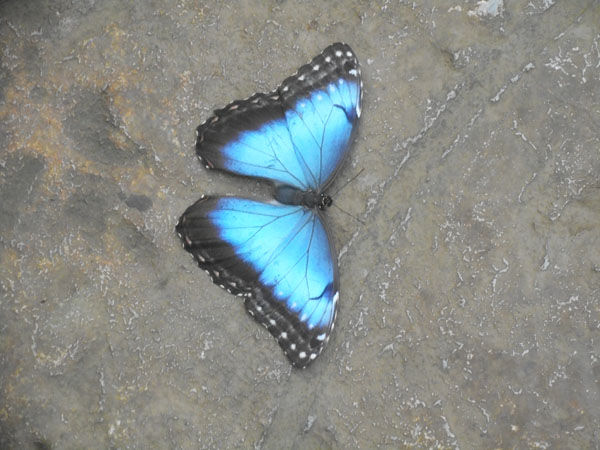 |
This is probably a morpho carepiller. The caterpillars of some of the other butterfly species they grow feed only on passion flower vines like those in the background.
The exhibit had many terreriums showing the plants and environments of both butterflies and other impressive insects... |
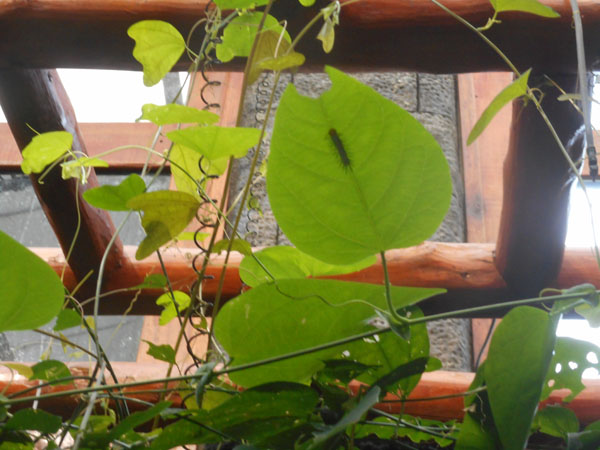 |
| ... like this one. |
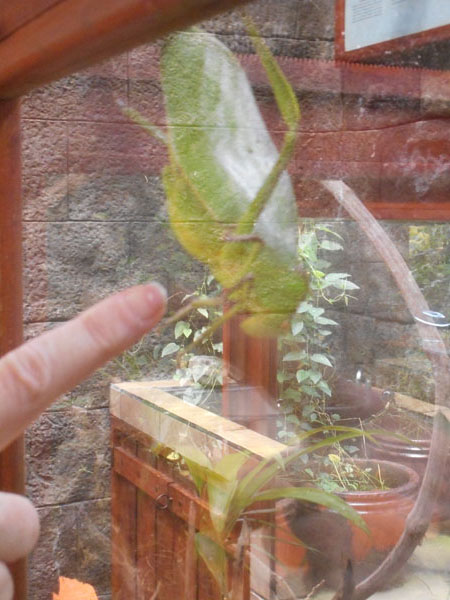 |
| Most of the exhibits were alive .... |
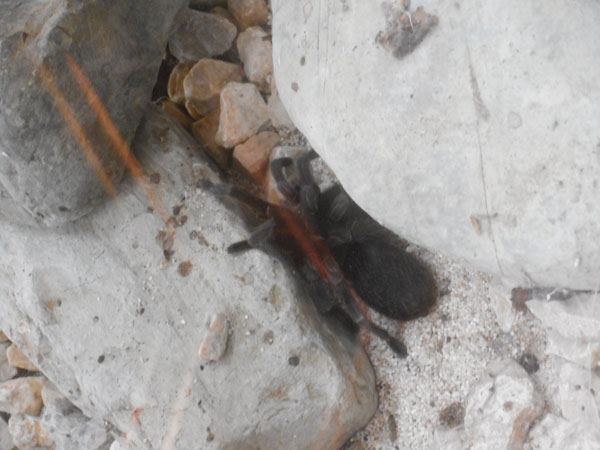 |
| ... but some were dead. |
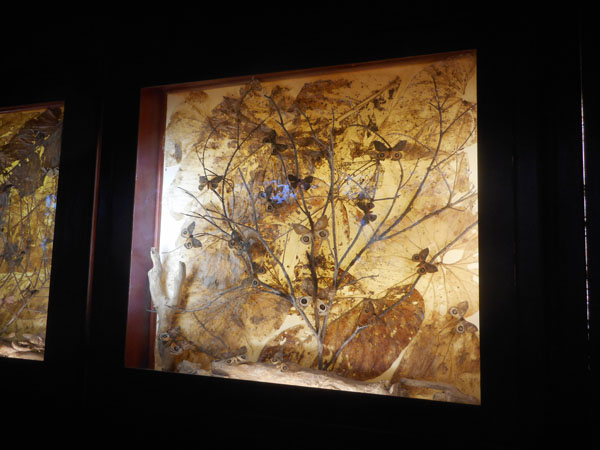 |
| |
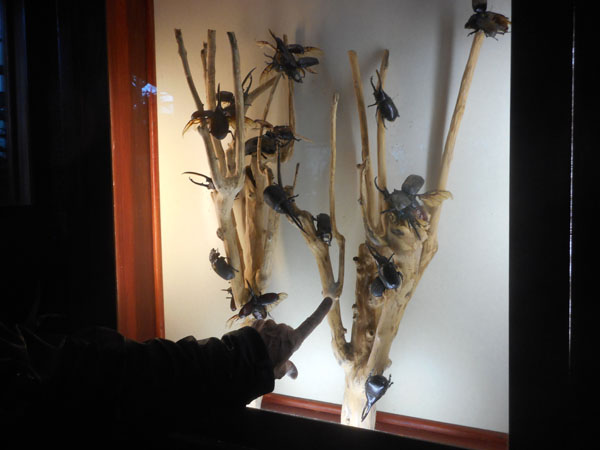 |
| (Karen was really glad these weren't in her shower) |
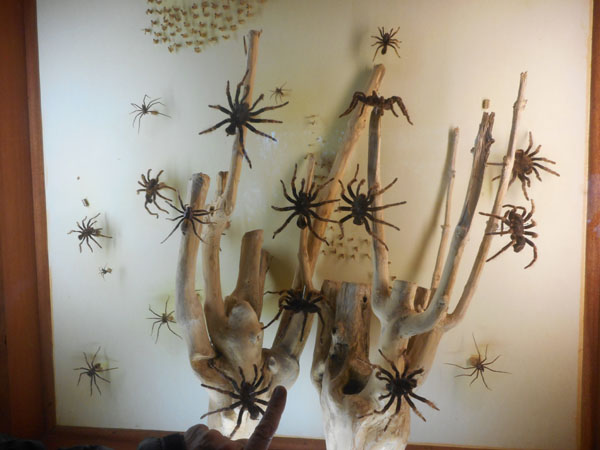 |
| After a dry half-hour, we went back out into the rain. With pauses to botanize, we went to the next group of buildings... |
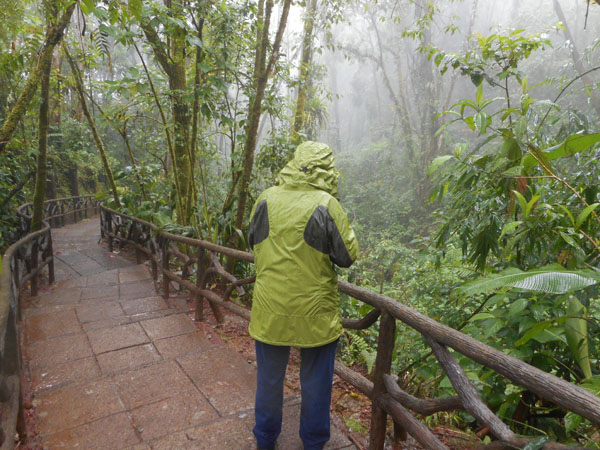 |
... which housed a variety of birds and animals. Like Zoo Ave, these were also rescued and owned by the goverment, and cared for under contract. Unlike Zoo Ave, there did not appear to be a "return to the wild" mission. They did appear to have an active breeding program. The larger animals had far less space than Zoo Ave had provided.
White-faced Capuichin |
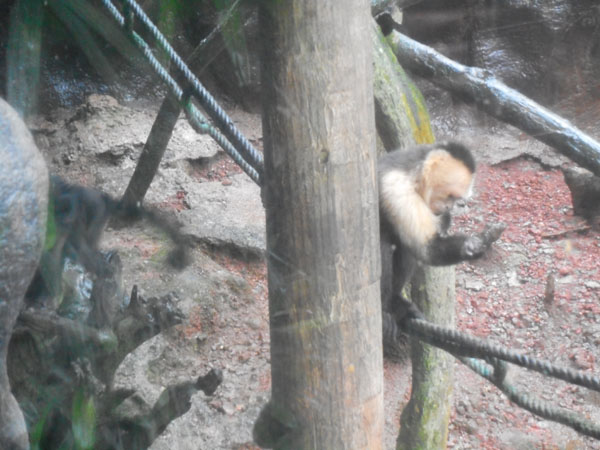 |
| sloths |
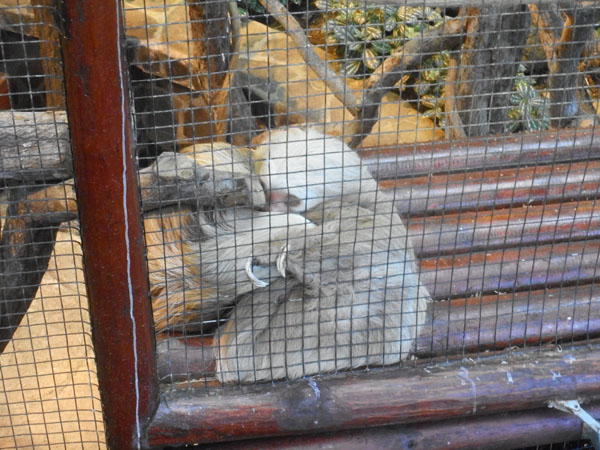 |
| another toucanette |
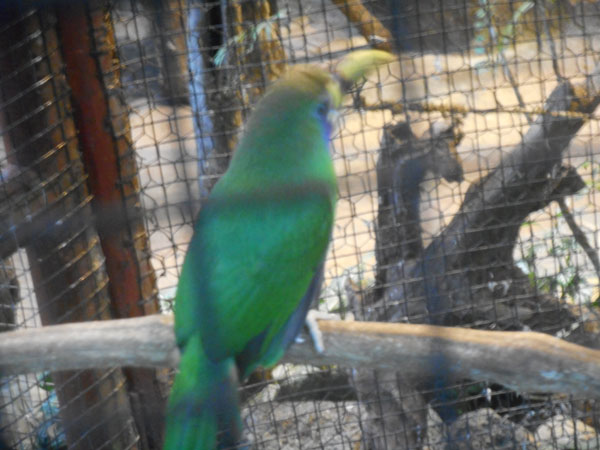 |
| In between buildings was a hummingbird feeding area. |
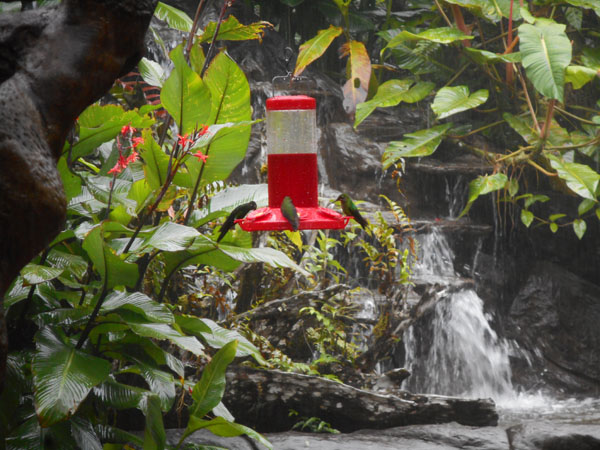 |
Oooh! A red plastic flower! With a sugar-water center!
Can I be your friend? |
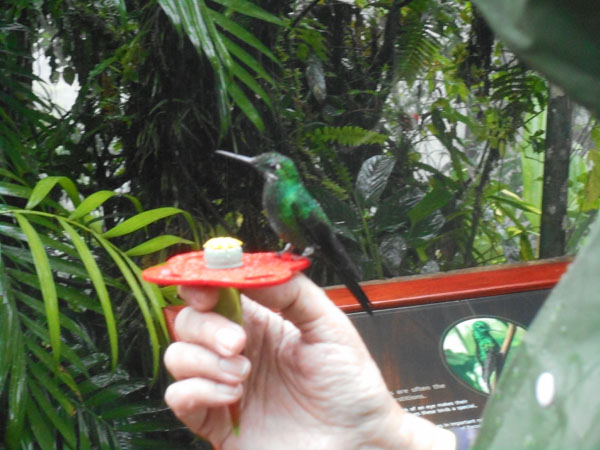 |
How many can you count?
(the rain was vacillating between "persistent" and "drenching") |
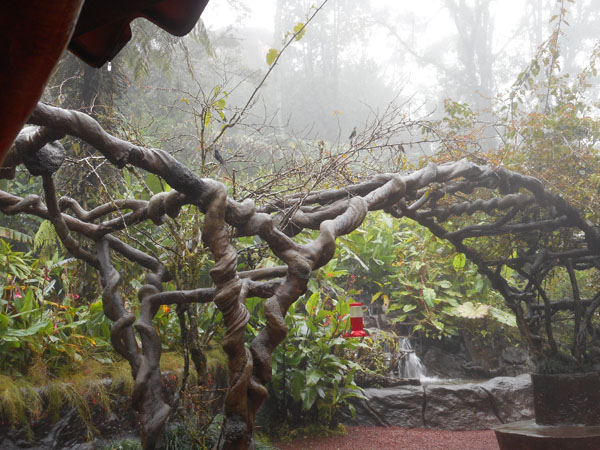 |
| |
 |
| Next up: reptiles. A green vine snake (Bejuquilla verde, Oxybelis fulgidus). |
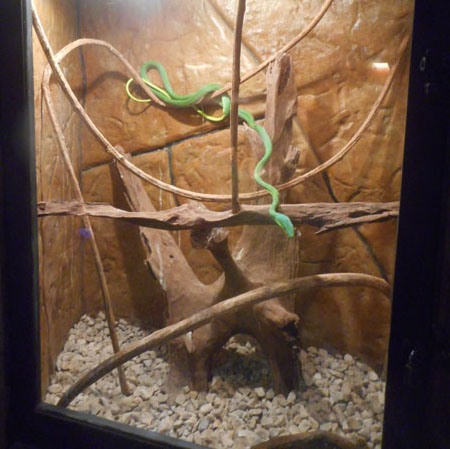 |
| A Nicaraguan Boa Constrictor (Bécquer, B.C. Imperator) |
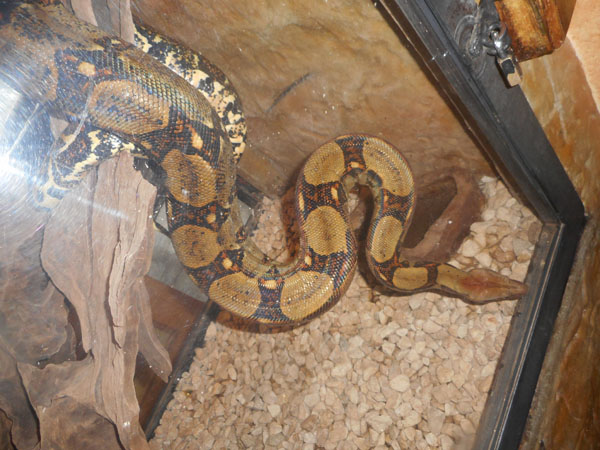 |
| |
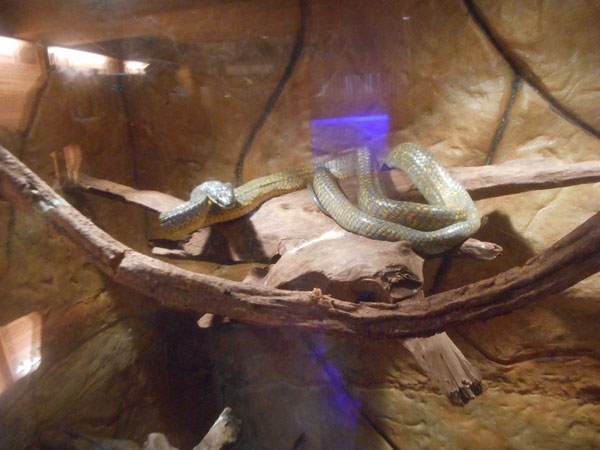 |
| and then cats. These are mountain lions. |
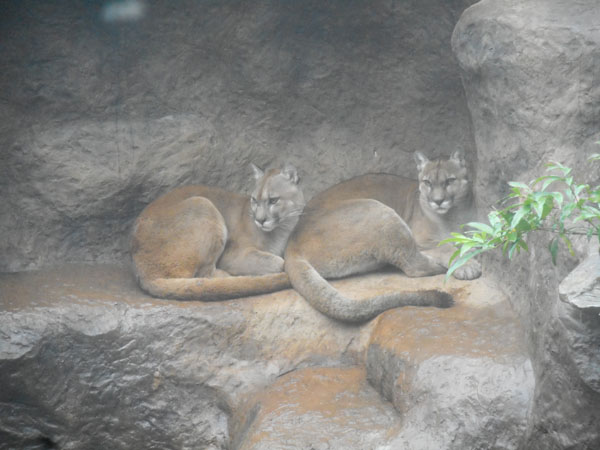 |
| Jaguars are noted for their large powerful jaws relative to their size. |
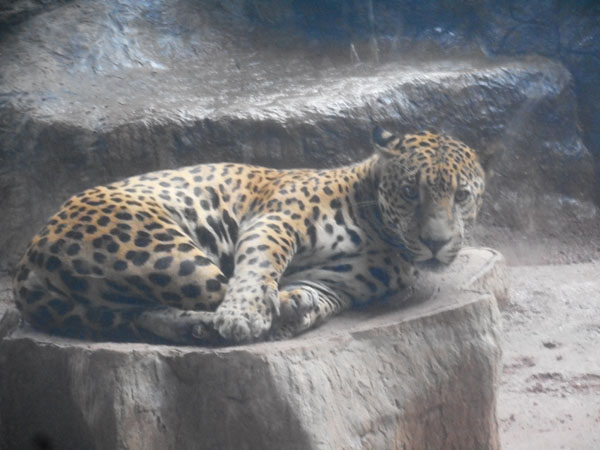 |
| This is one of the smaller species (oncilla?) |
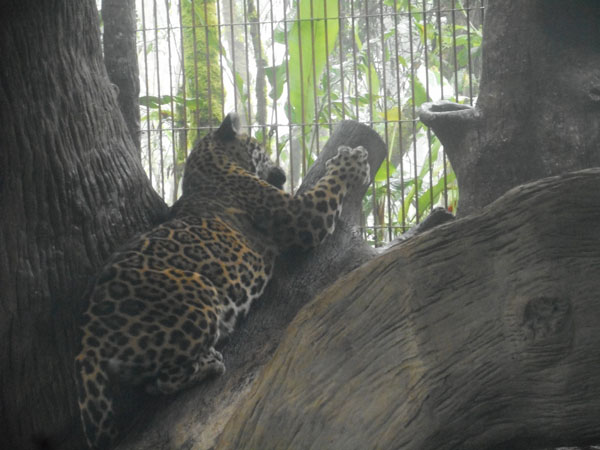 |
| and a Margay |
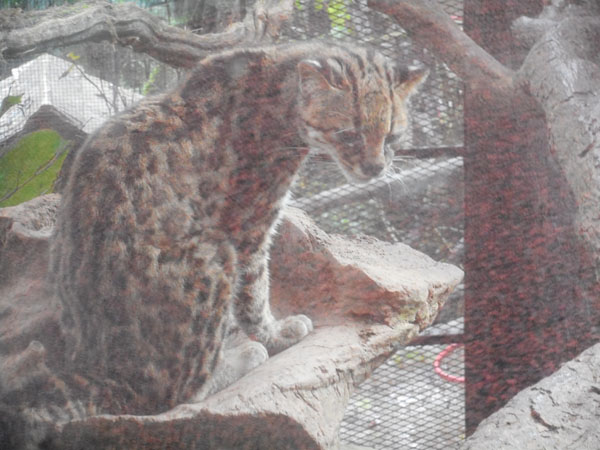 |
Then on to the frog house. Well done but most of the the frogs were hiding and difficult to photograph. This one was imitating bird droppings.
The staff had gone through in the morning and placed the identifying tags on the plants where they found any frogs. They had a dining-room-sized greenhouse full of plants that they could free-roam (and hide) among. |
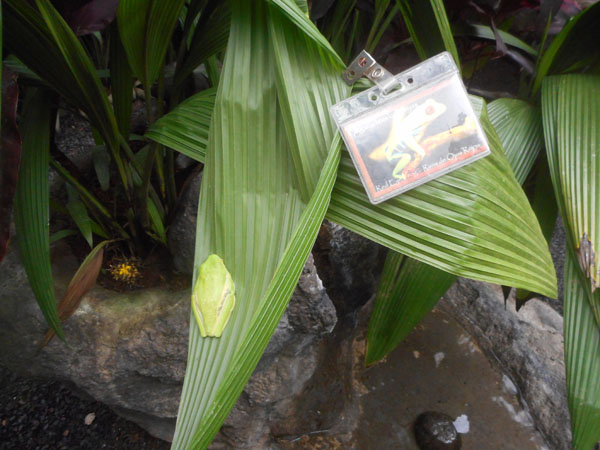 |
| The last building was candle-lit replica of the original farmstead complete with a costumed person serving warm sugar cane juice and corn pudding. |
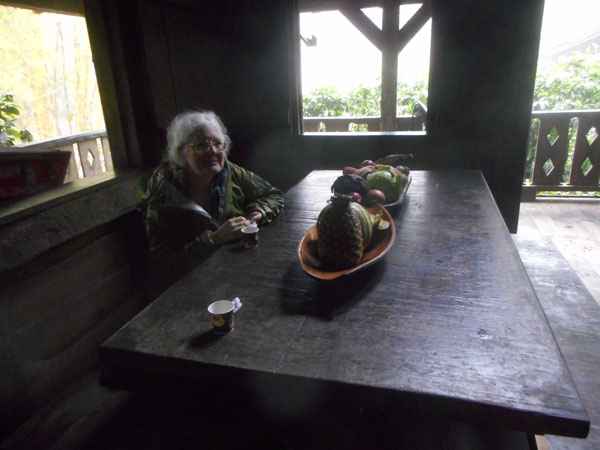 |
| And the iconic oxen and cart with painted wheels. |
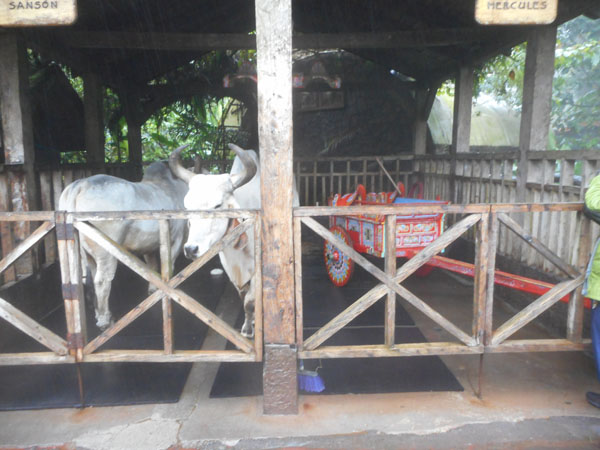 |
| one last look uphill before |
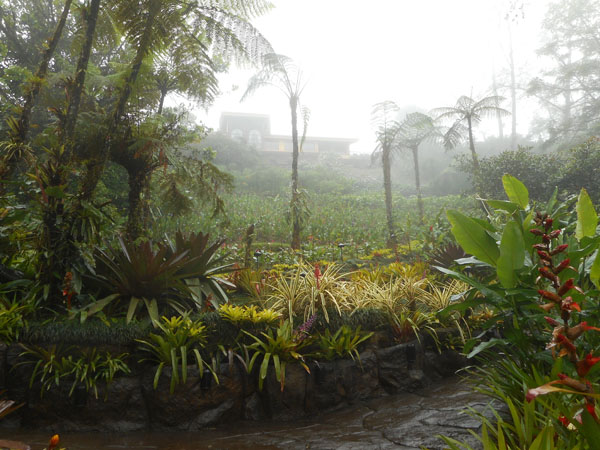 |
going off (and down) on the path to the 5 waterfalls.
Definitely a rain forest... |
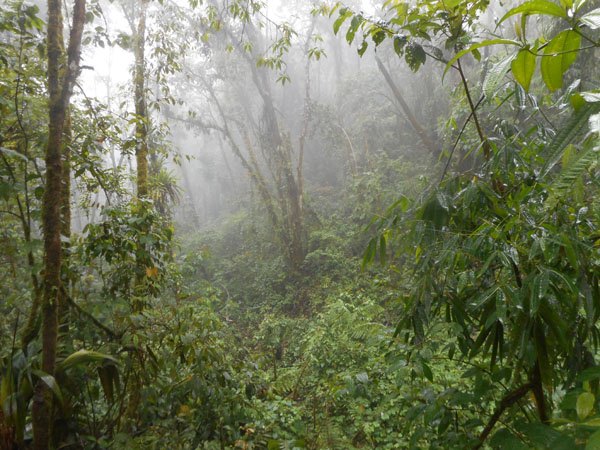 |
| Cascades and the roaring La Paz river... |
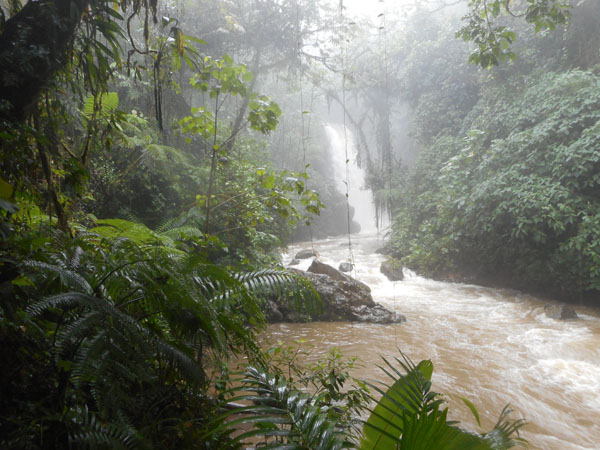 |
| stepping down.... |
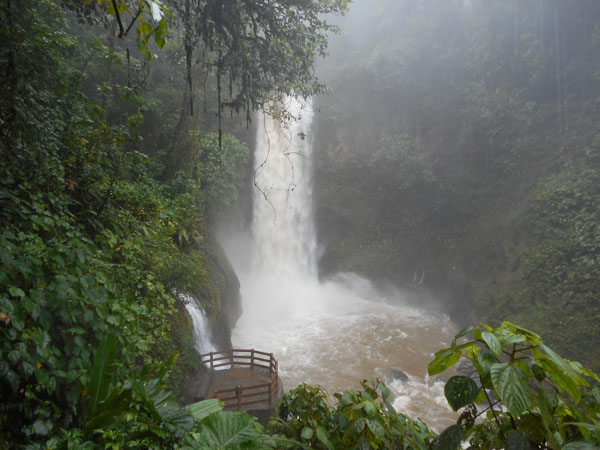 |
| ... and down ... |
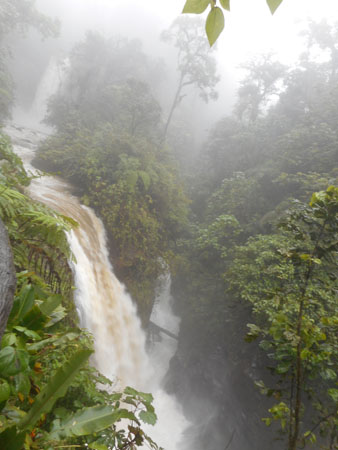 |
| At the bottom end's gift shop, we passed on the opportunity of al fresco snacks and coffee... |
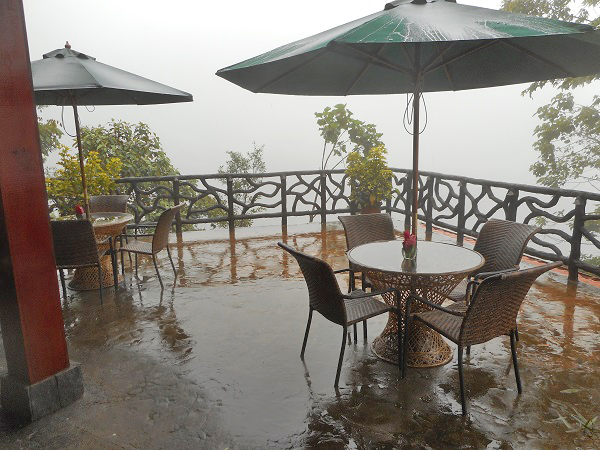 |
| ... and rode a van back uphill to the lodge and parking lot. |
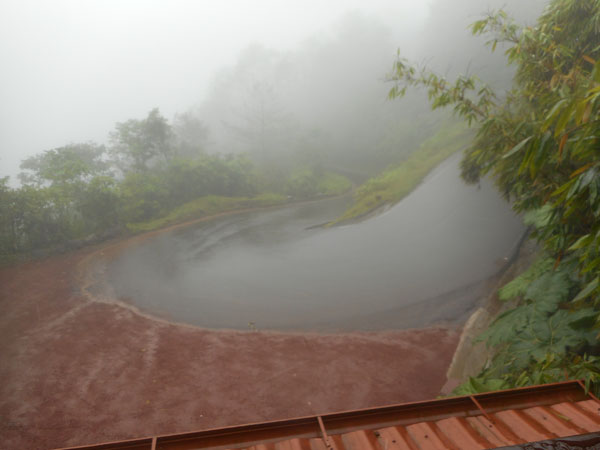 |
| Coming back towards Alajuela we could see that down in the valley the weather was dry |
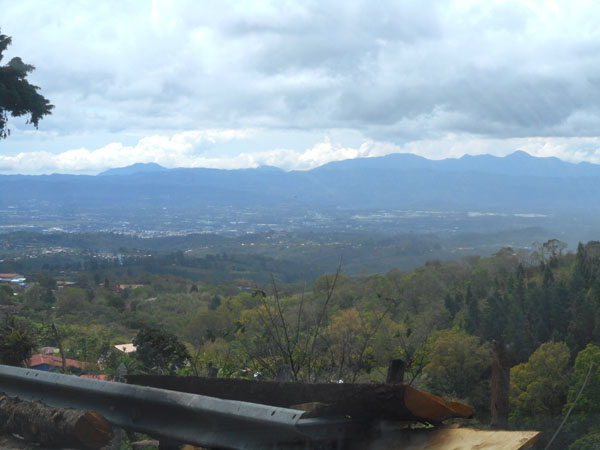 |
| People were even hanging out their washing |
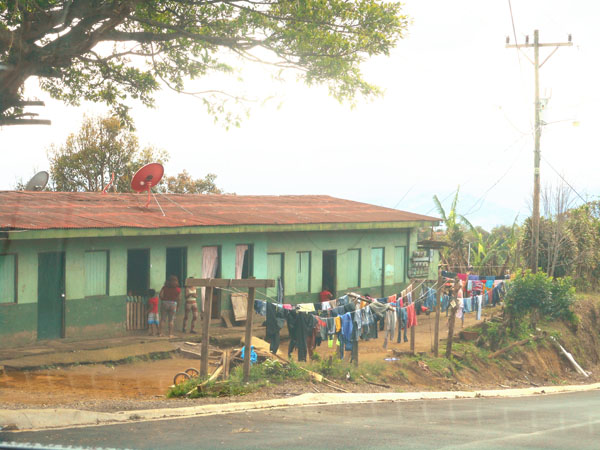 |
We hung up our own wet clothes as soon as we got home.
This had been the wettest day we endured outdoors in Costa Rica... there were two other days that had some rain, but this one took the soggy biscuit... |
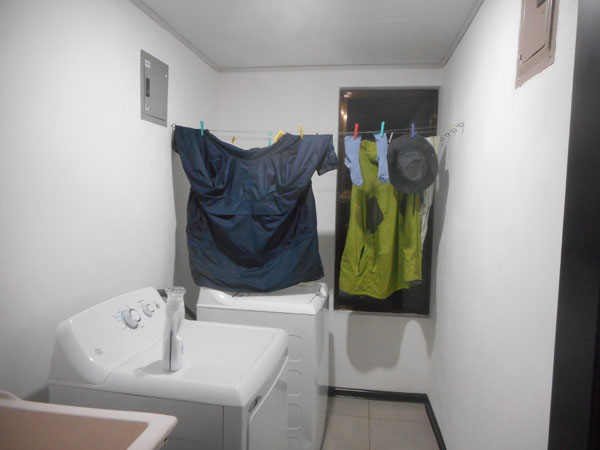 |
| Alajuela contributed another gorgeous close of the day |
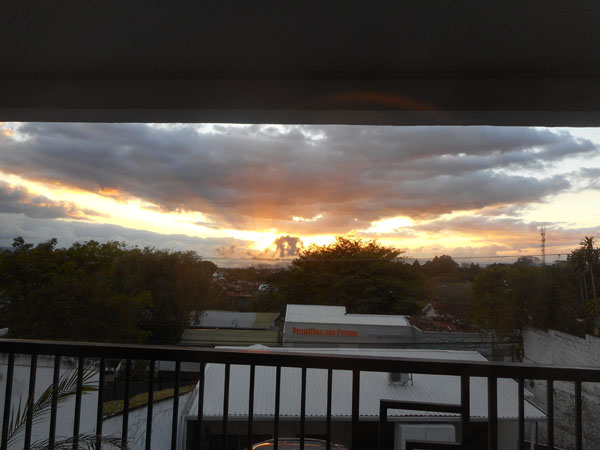 |
| And a (adequately distant) rainbow in the morning |
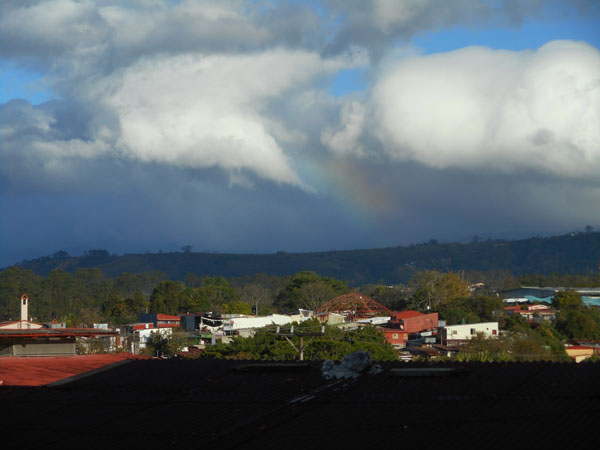 |
| After breakfast it didn't look so wet, so we set off to visit the Else Kientzler Gardens in Sarchí Norte. This finally put us on a segment of the Pan American Highway. Our cameras' slow wake-up times didn't let us catch the most thrilling things coming towards the windshield. This is merely a typical road scene: vehicles double parked directly opposite each other on a curve. Usually with pedestrians or bicycles traveling in the road at that point too. |
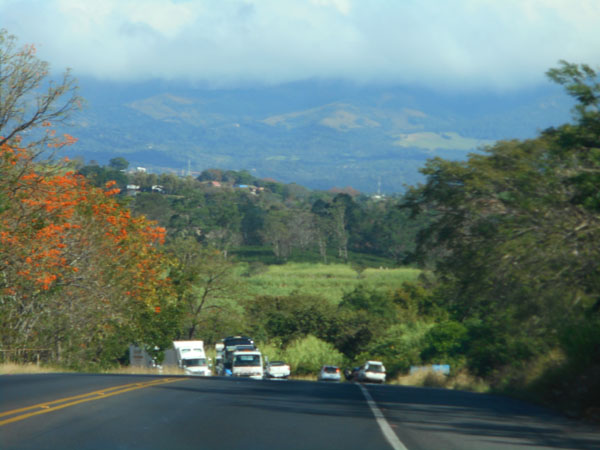 |
| Jardín Else Kientzler is a private garden and greenhouse operation started in 1904. Else was the wife of the son of the founder, and took over the company upon her husband's death in 1960. The garden is nestled in a small valley, with a large selection of different tropical species from places like Guiana, New Zealand, Madagascar, Japan, Bahamas, Java, Brazil, India, Korea and Costa Rica. There are several themed gardens such as succulents, bromeliads, as well as a sample of timber trees in danger of extinction. and a zingiberal (ginger, banana, heliconia) garden. |
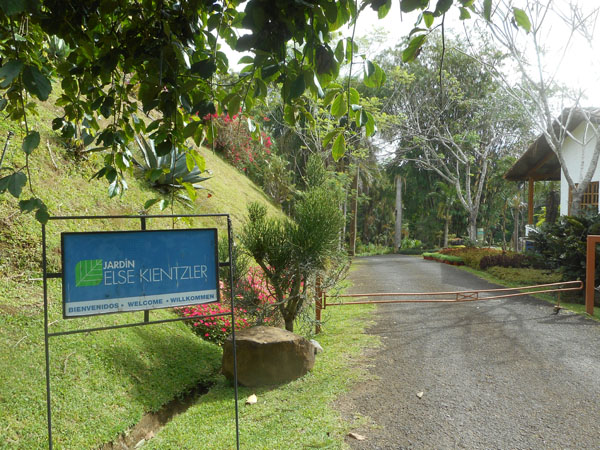 |
| With particularly well-worded "don't eat the plants" sign. |
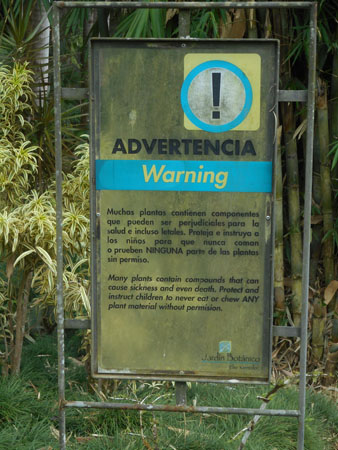 |
| There were paths through landscaped groupings of similar plants |
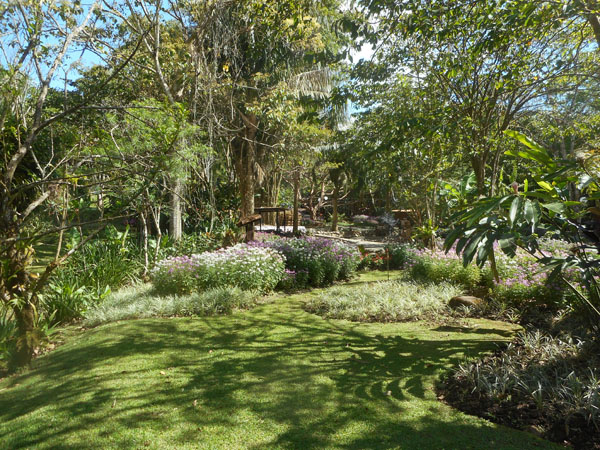 |
| in the midst of wild |
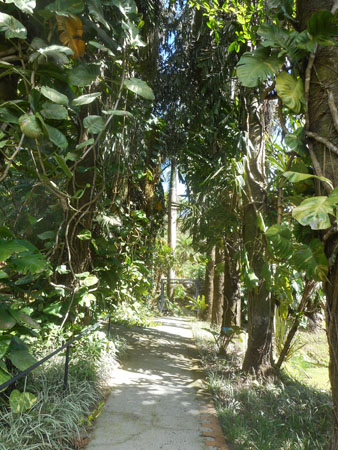 |
| |
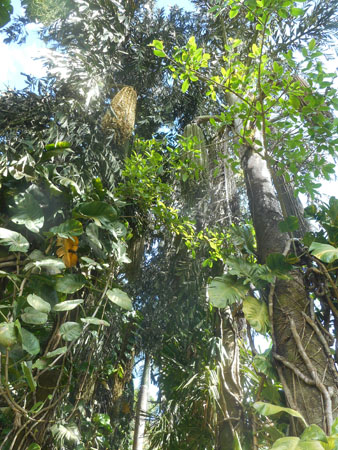 |
| The gardens had a few sections that are designed for events -- they were probably setting up for a wedding |
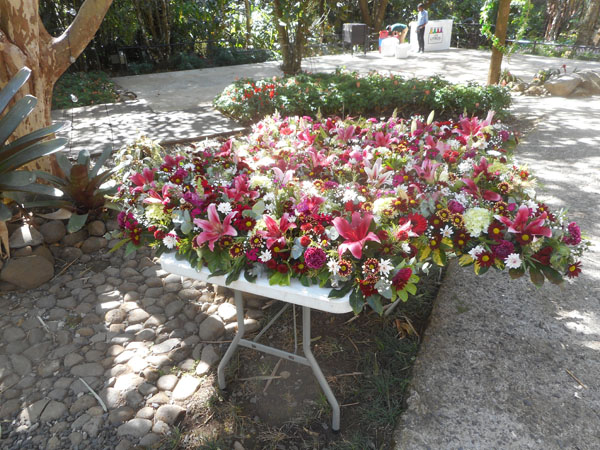 |
| And it was being used for a photoshoot. |
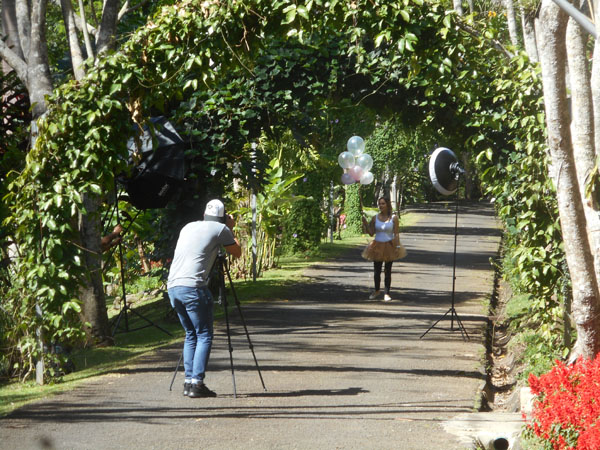 |
| Remember the Poró (Erythrina) tree in the Orchid Garden? Here's another better showing its orange flowers and petal-strewn walkway |
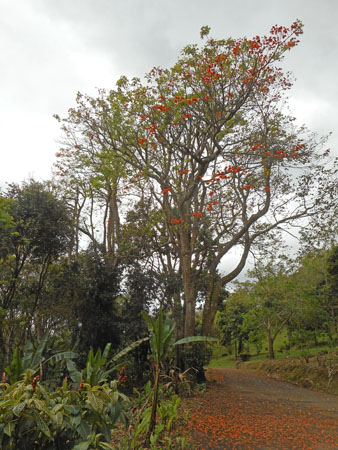 |
| One path went up and skirted the upper boundary of the property... there was a stream running on one side, wild-feeling growth on the other side, which was a steep slope down to the more docile areas. |
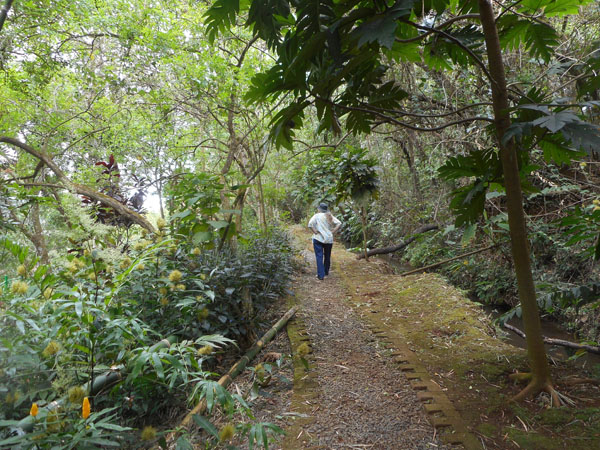 |
| We saw this short red banana all over. This one is just starting to bloom. I don't think people eat it: the fruit is mostly seeds. |
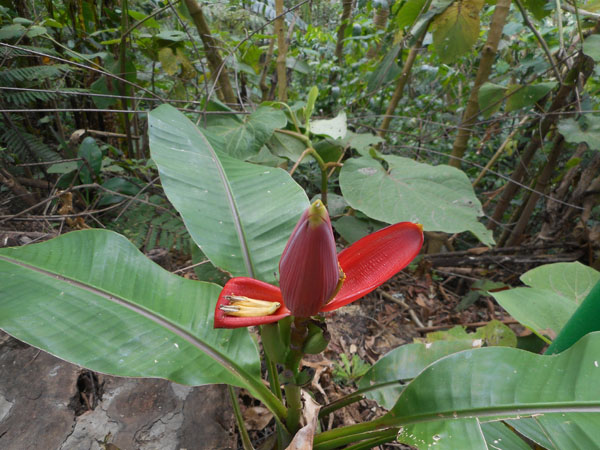 |
| This is a more typical banana. See the fruit up the stalk, near the top of the photo? |
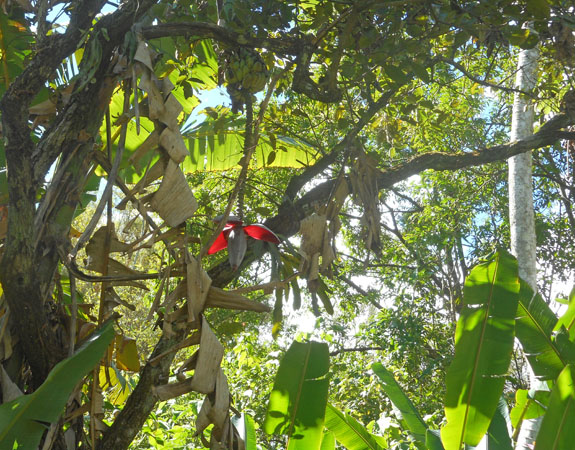 |
| After fruiting that stalk dies. Here's what the cross-section looks like. |
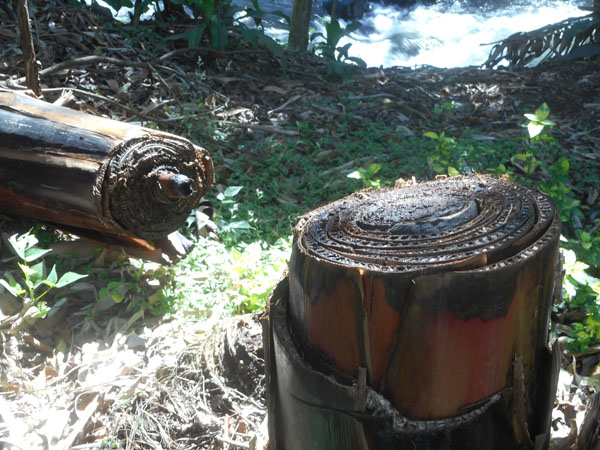 |
| They say young red-brown foliage like this mimics dead leaves to fool herbivores. I'd like to see how that theory was tested. |
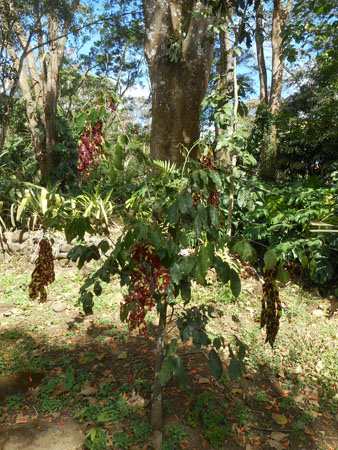 |
| Another species seen with the orchids, an Aristolochia flower |
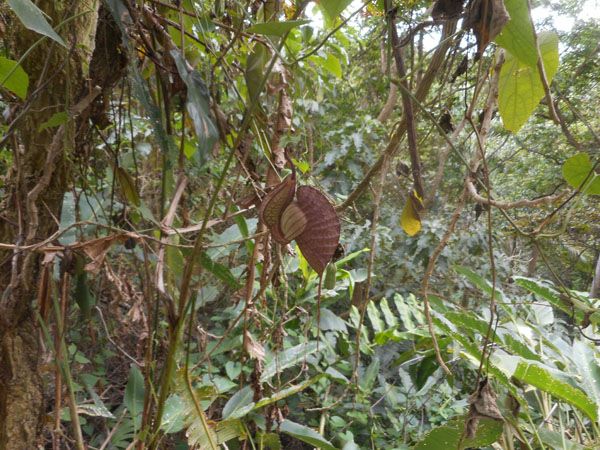 |
| Aristolochia fruit (the hanging basket) and what might be Mimosa flowers |
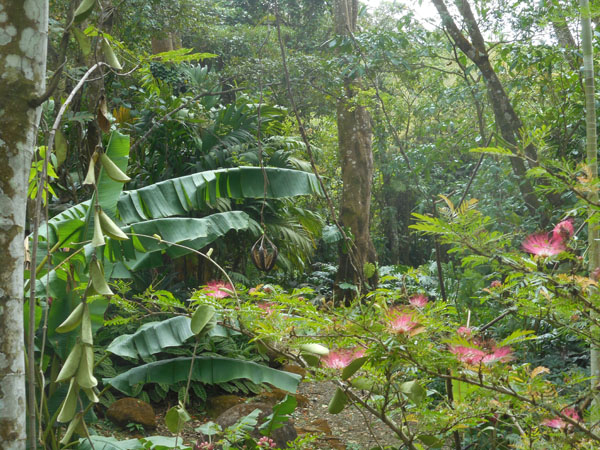 |
| Palm flowers and fruits |
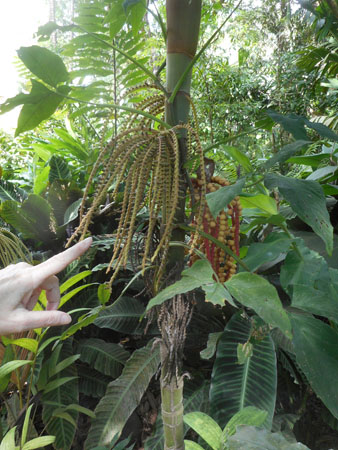 |
| Flowers that look like little slipper shells. Cute, but we don't know what they are. |
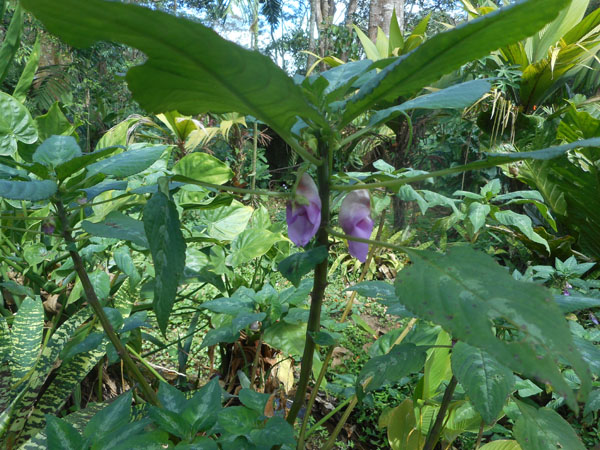 |
| Begonia -- like your house plant. |
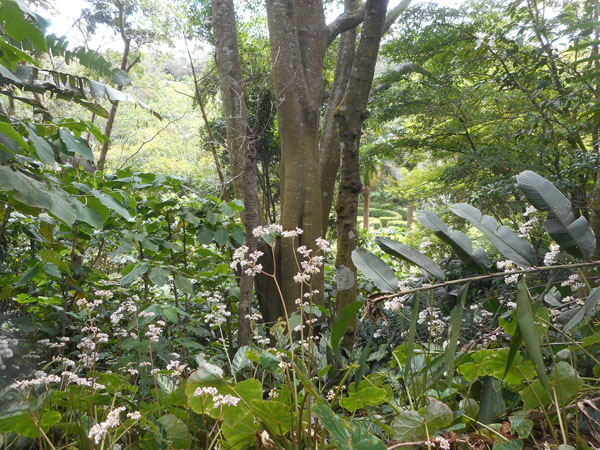 |
| One of our few butterfly shots that actually still had the butterfly in it. |
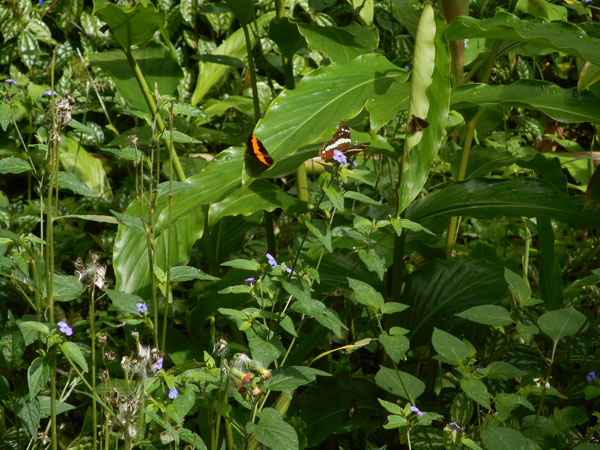 |
| Tree ferns always grab Karen's attention. |
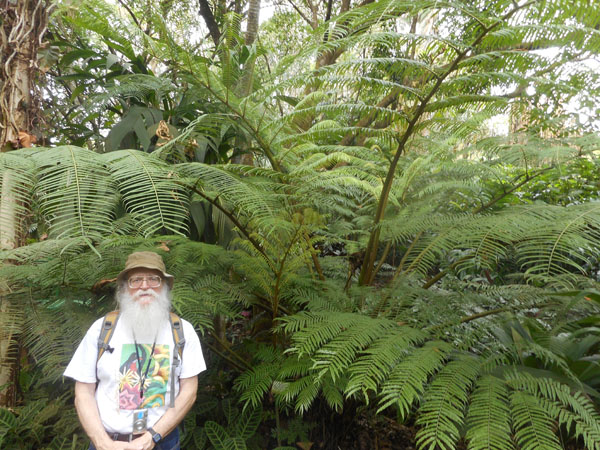 |
| ... as did almost every plant along the paths. |
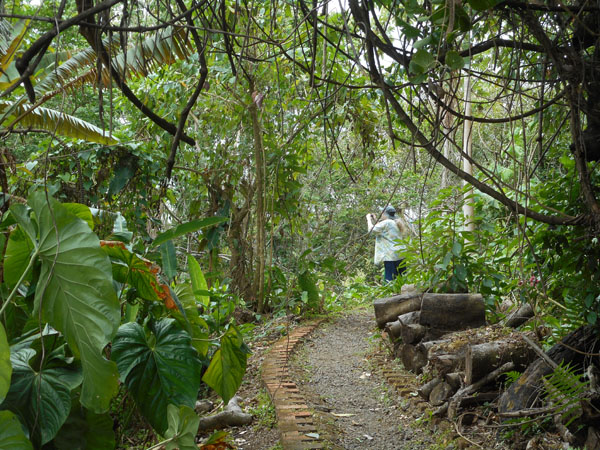 |
| a small unmanicured stream |
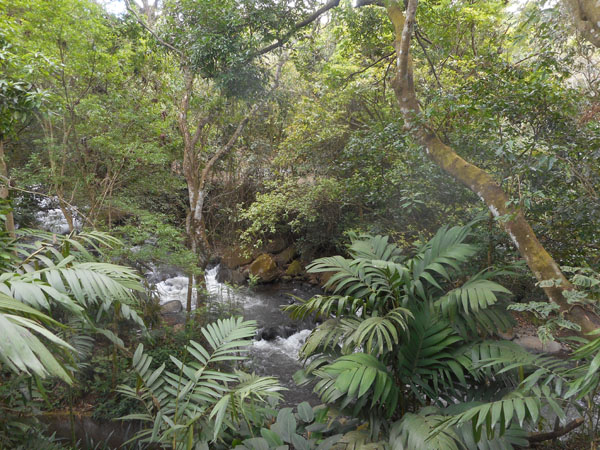 |
| an interesting ant nest (with shoe-toe for scale) |
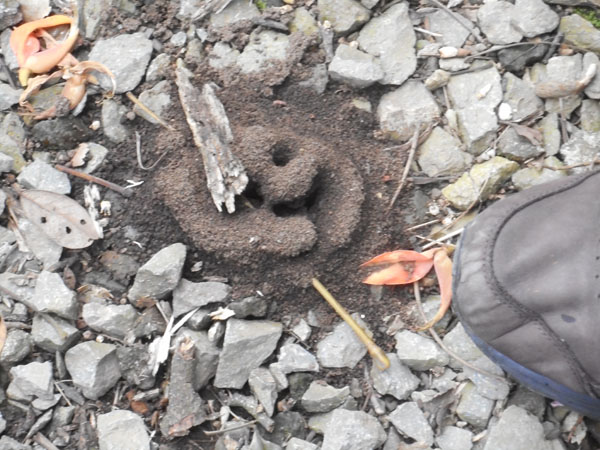 |
| and a similar shaped sculpture |
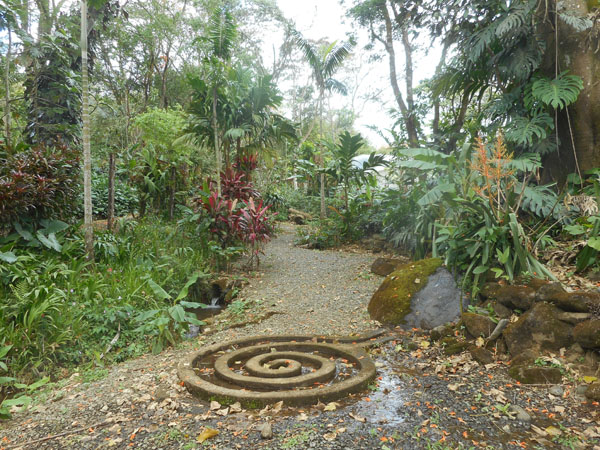 |
Don't want to try climbing this one. |
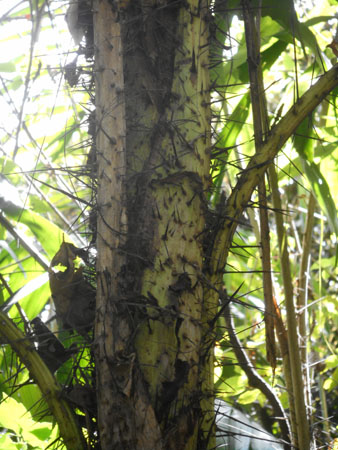 |
| Blooming bromiliad |
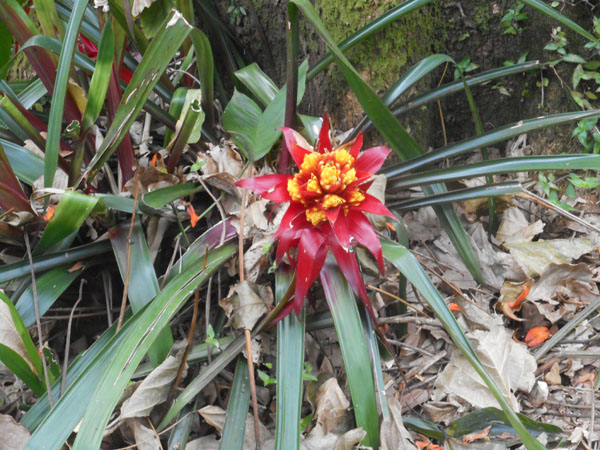 |
| Pitcher plants |
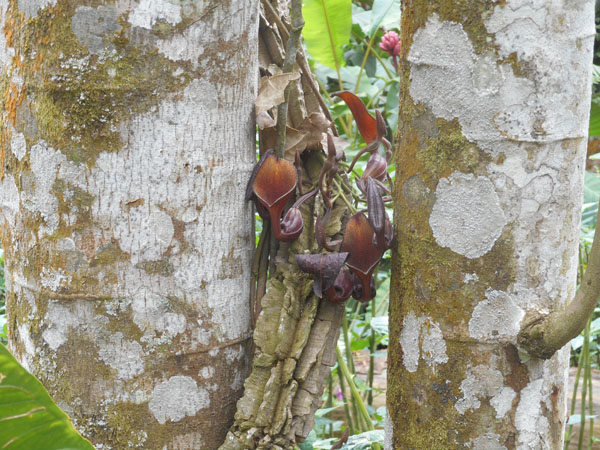 |
Ginger (probably not the one you eat), a relative of bananas
(one of the zingiberales) |
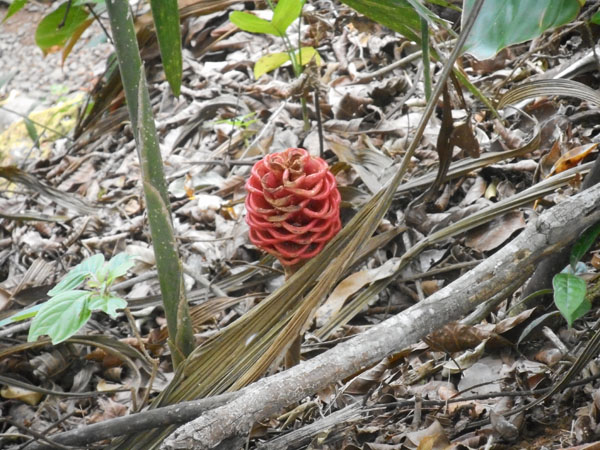 |
| Bird of Paradise, another banana relative. |
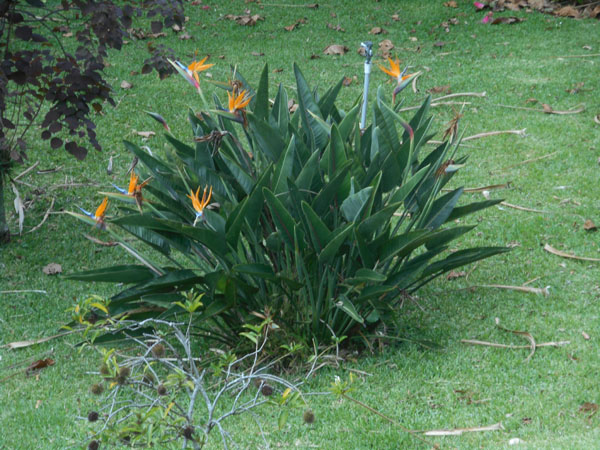 |
| Bamboo with blooming ginger at the bottom of the photo |
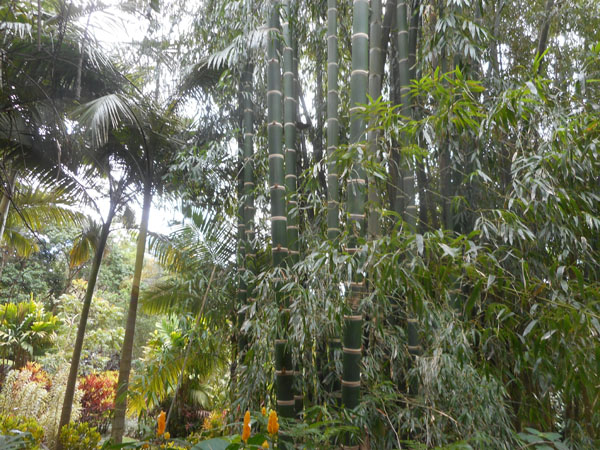 |
| The maze |
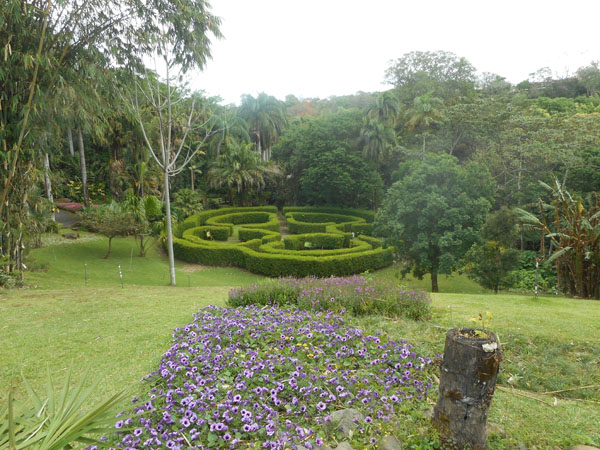 |
| ... and the children's play yard. Just as we walked away we saw a multigenerational family with a picnic approaching this area. We get the idea that the space is well loved by the community. |
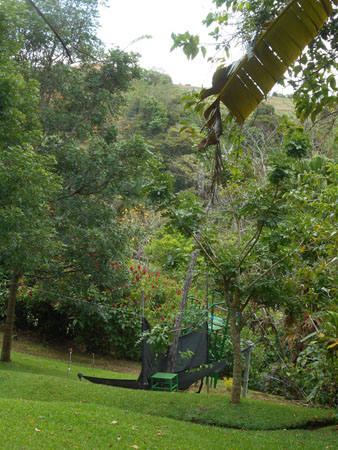 |
| A climb up the hill (probably so there would be good drainage) |
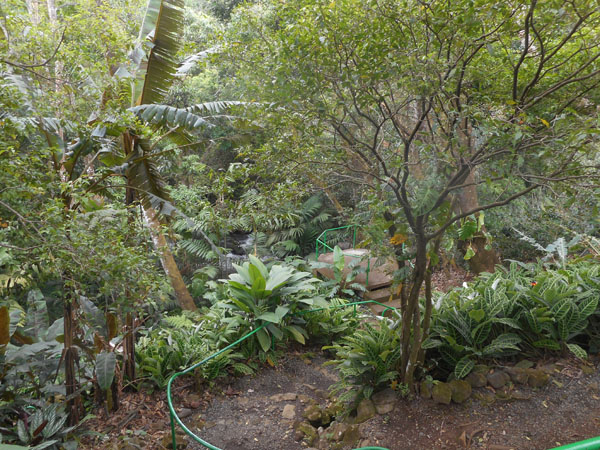 |
| ... to the cactus and succulent garden. |
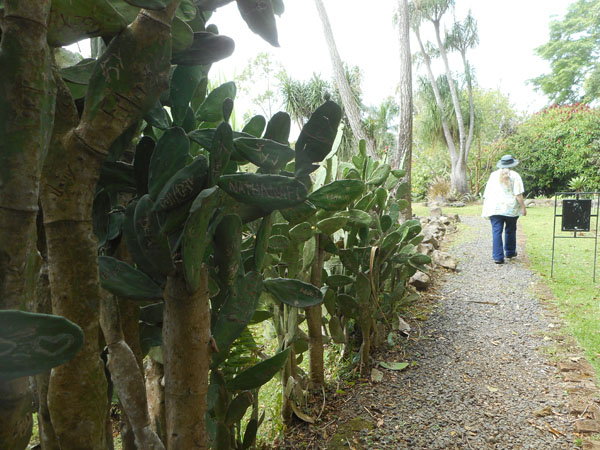 |
| |
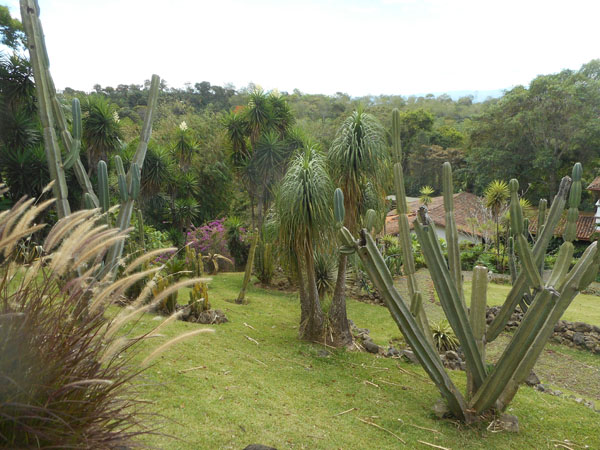 |
| Back in central Sarchí Norte, we saw this colorful ox-cart wheel to advertise a restaurant/butterfly farm/furniture shop. |
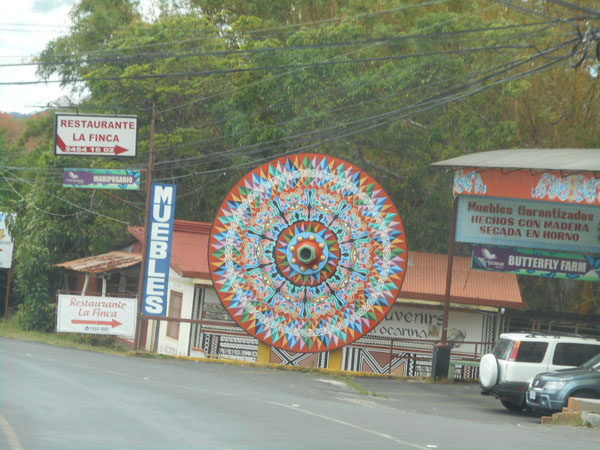 |
| Taking a different route back from Sarchí, the GPS took us on another "shortcut"... but we were pleased: it brought us through this lovely valley of the orange Erythrina trees (and the road was paved). |
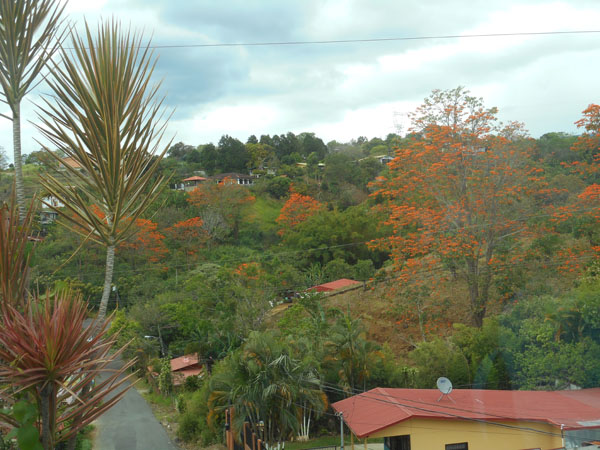 |
| The shortcut took us on a wandering trip through a neighborhood that had this grand strangler fig. |
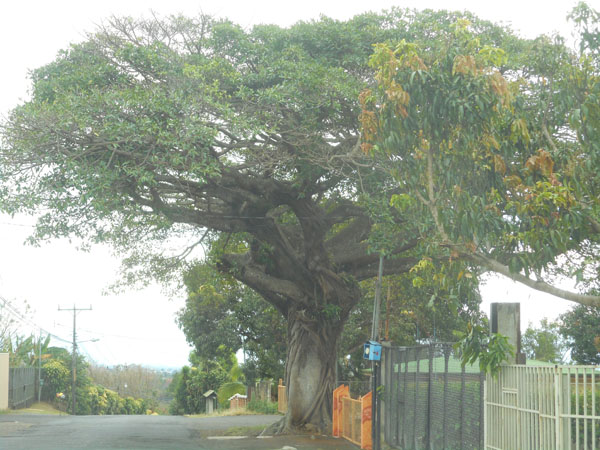 |
| Getting back into Alajuela, we passed by the local theater. |
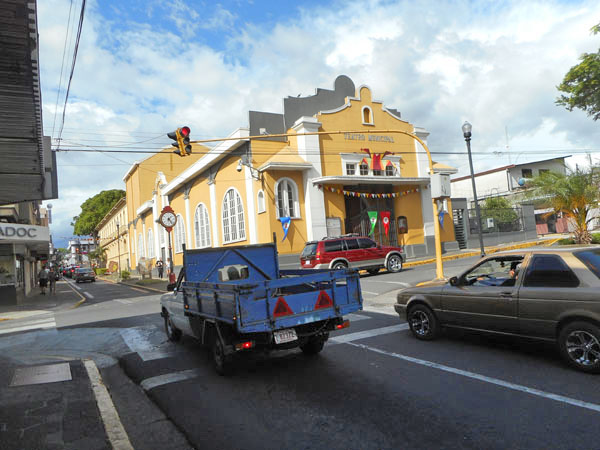 |
| On one of Dick's walks from the apartment to the AutoMercado, he came across this bicycle club preparing for (or recovering from) a ride. |
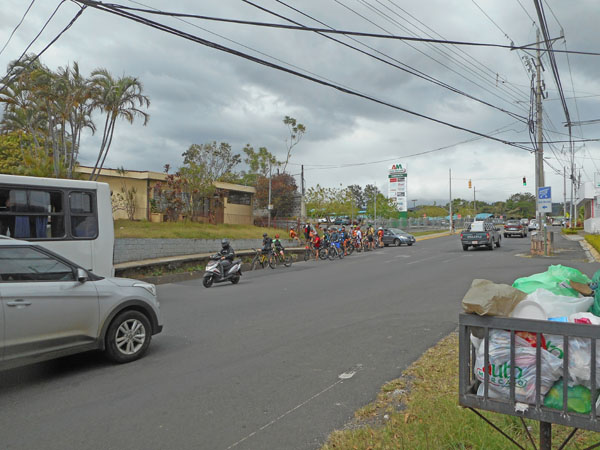 |
| Another lovely end to the day |
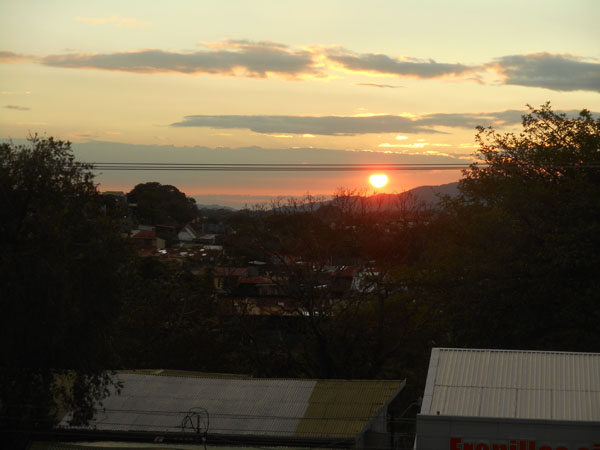 |
And the moon came out to say good night.
Tomorrow we leave for Cachí. |
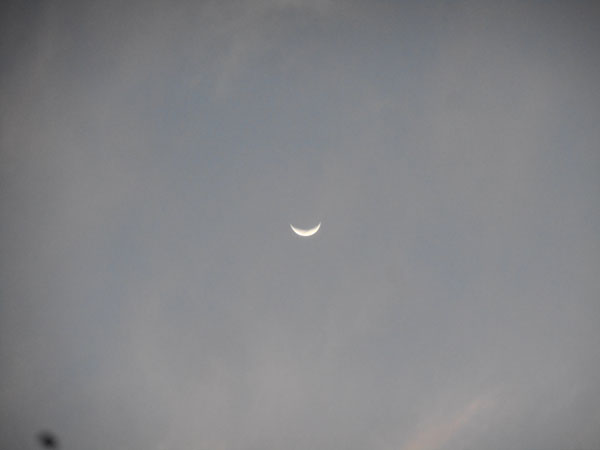 |













































































































































































